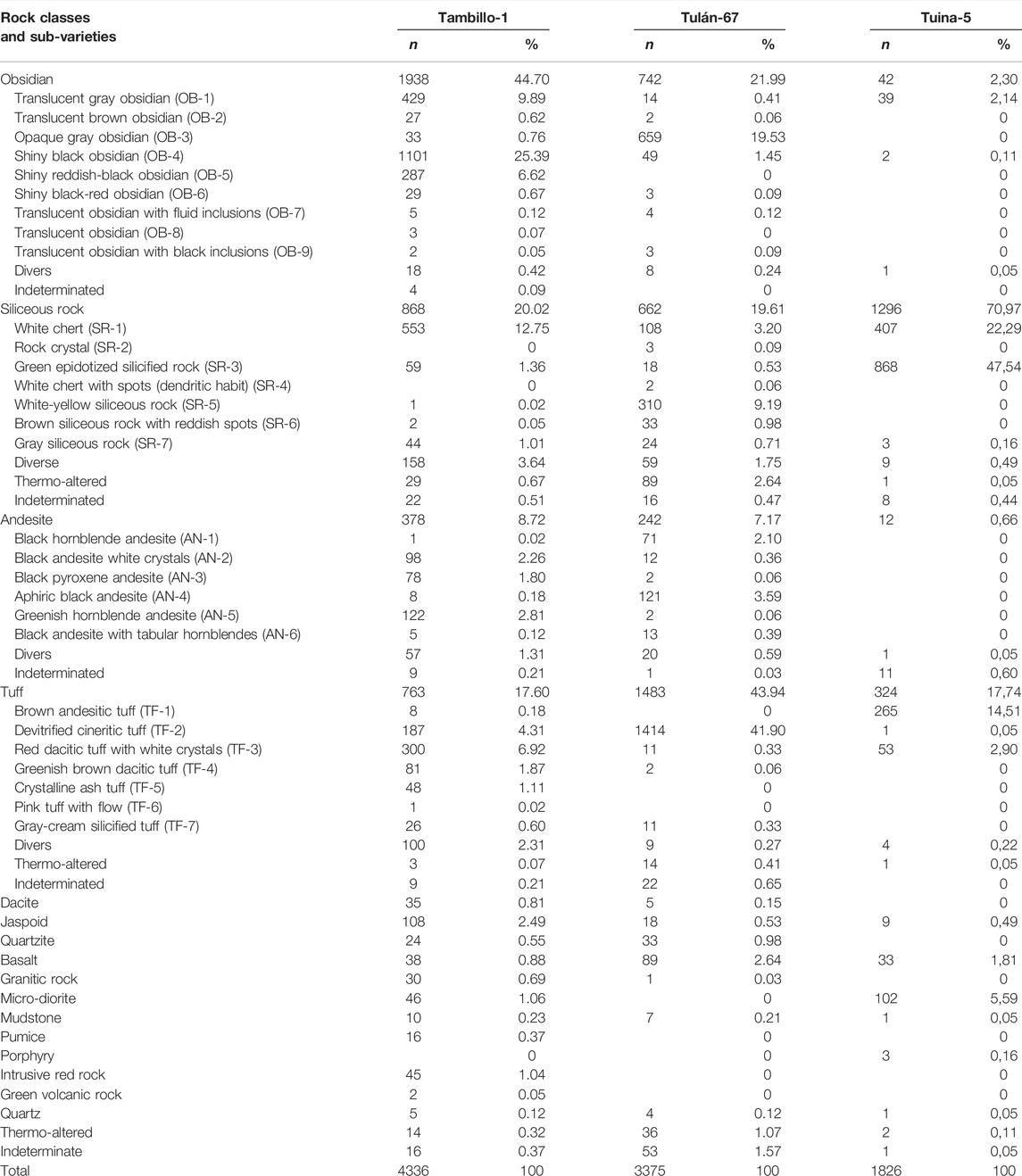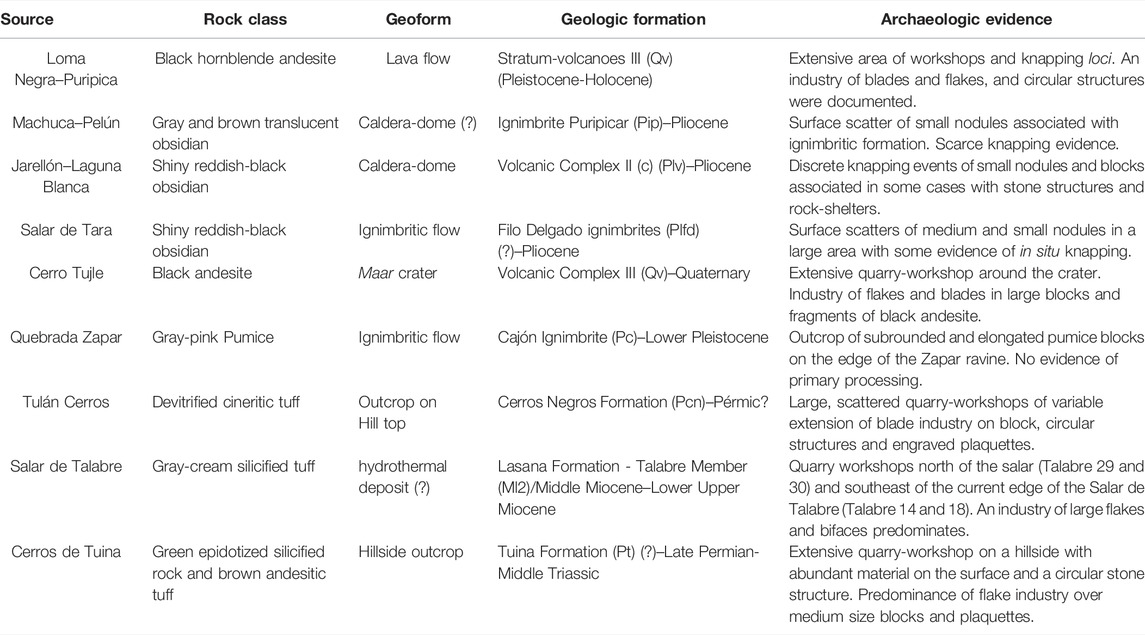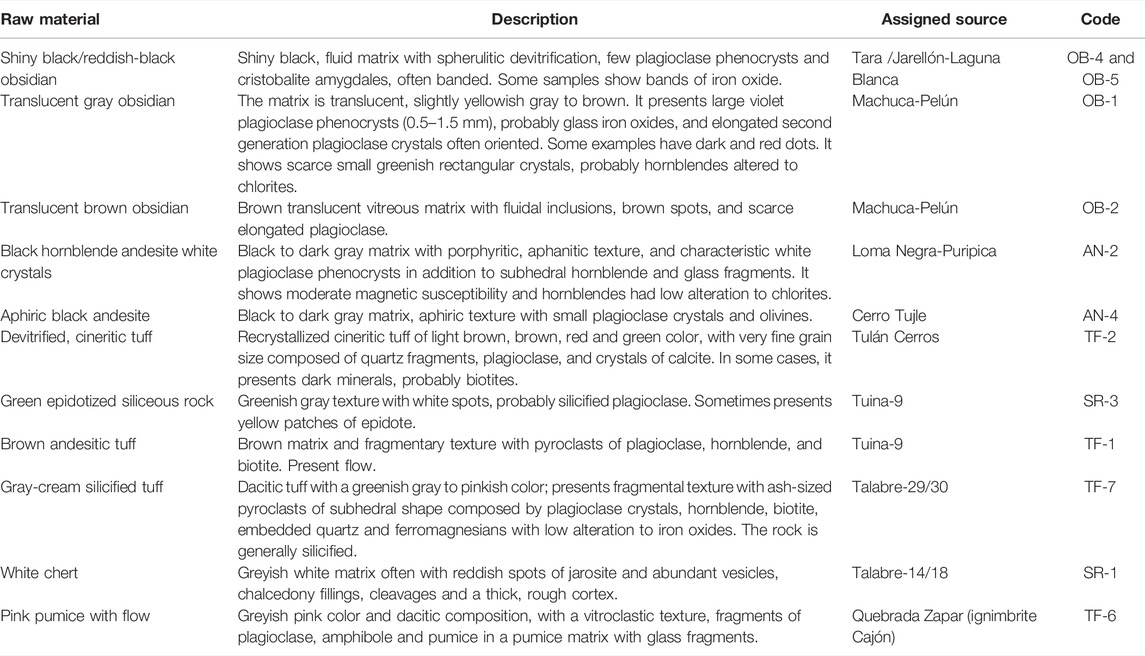The Volcanic Landscapes of the Ancient Hunter-Gatherers of the Atacama Desert Through Their Lithic Remains
- 1Instituto de Investigaciones Arqueológicas y Museo, Universidad Católica del Norte, San Pedro de Atacama, Chile
- 2UMR 8068 Technologie et Ethnologie des Mondes PréhistoriqueS, Université Paris Nanterre, Nanterre, France
- 3Departamento de Ciencias Geológicas, Universidad Católica del Norte, Antofagasta, Chile
- 4Comunidad Atacameña de Toconao, San Pedro de Atacama, Chile
- 5Millennium Institute of Astrophysics, Santiago, Chile
- 6Departamento de Ciencias Históricas y Geográficas, Facultad de Educación y Humanidades, Universidad de Tarapacá, Arica, Chile
Since ancient times Andean societies have formed an intimate relationship with volcanoes, the beginnings of which can be traced right back to the initial peopling of the region. By studying rocks used for stone tools and other everyday artifacts, we explore the volcanic landscapes of early hunter-gatherer groups (11,500–9,500 cal BP) of the highlands of the Atacama Desert (22–24°S/67–68°W). Petrological classification of the lithic assemblages of three Early Holocene archaeological sites showed the procurement of a great diversity of volcanic and subvolcanic rocks, including pumice, granitic rocks, micro-diorites, a large variety of tuffs and andesites, dacites, cherts, basalts, obsidians, among others. Field surveys enabled us to detect many of their sources related to volcanic features such as craters, maars, caldera-domes, lava flows, probable hydrothermal deposits, and ignimbrites. In these places, we also document large quarry-workshops and campsites from different periods, indicating intense and repeated human occupation over time. By comparing the artifacts with geological samples collected in the field, it was possible to assign the source of origin of a large part of the archaeological assemblages. Our data suggest that the volcanic features of the Atacama highlands were integrated into the mobility and interaction networks of ancient hunter-gatherer groups at an early date.
1 Introduction
In the Andes region, volcanism is a multidimensional phenomenon that permeates different aspects of the everyday life and worldview of human societies. In the Andean cosmovision, volcanoes represent deities that are the subject of devotion and offerings during both ceremonial occasions and everyday prayers. As was remarked by Harris and Bouysse-Cassagne, they are mediators that allow communication between the surface and the underworld known as the “mancca pasha” (Bouysse-Cassagne and Bouysse, 1984; Bouysse-Cassagne and Harris, 1987; Harris, 1987; Bouysse-Cassagne and Bouysse, 1988). In Inka times, volcanoes and the high peaks of the Andes range were the scenario of complex rites and human sacrifices known as capaccocha (D’Altroy et al., 2007; Reinhard and Ceruti, 2010; Mignone, 2010; Mignone, 2015). Volcanic features were also used as geographic markers for the observation of astronomical events and the reproduction of the annual cycle as the case of the Llullaillaco Volcano (Sanhueza, 2004). For pre- and post-Columbian communities, they were also geographical landmarks used for spatial orientation, especially by travelers and caravans that crossed the mountain passes and the Atacama Desert (Núñez and Dillehay, 1979; Berenguer, 2004). Eruptions were not only catastrophic disasters; they were complex events that affected recurrently the cultural dynamics in the past (Bouysse-Cassagne and Bouysse, 1984; Bouysse-Cassagne and Bouysse, 1988; Pärssinen, 2015).
In the highlands of the Atacama Desert (south-central Andes), research carried out over the last 20 years into the early peopling has revealed abundant lithic industries in stratified deposits (Núñez et al., 2002; Núñez et al., 2005). The lithic assemblages recovered in various archaeological sites include a wide variety of stone tools used for different purposes: hunting large and small game; grinding plants; processing fur, wood and pigment, and the manufacture of ornaments (Loyola et al., 2019a). These objects were tremendously important not only for subsistence but also for the reproduction of social life; they were even included as offerings in ceremonies and mortuary rites in later periods or used as exchange goods (Loyola et al., 2021). The sources and diversity of these rocks, mainly of volcanic and subvolcanic origin, give us clues about the early links of these ancient populations with Andean volcanoes. Beyond the catastrophic effects of eruptions, this record allows us to approach the relationship between the first hunter-gatherer societies and volcanism in their daily lives.
Using an interdisciplinary and geo-archaeological approach, we studied the lithic assemblages recovered from three archaeological sites dated between 11,500 and 9,500 cal BP: Tuina-5, Tulán-67 and Tambillo-1 (Núñez et al., 2002; 2005). After lithological classification of the lithic raw materials, surveys were carried out on wide spatial scales which allowed us to document at least 10 sources of lithic procurement in an area of more than 10,000 km2. Most of them correspond to volcanic and subvolcanic formations, resulting from the active volcanism of the Andes in different geological epochs. Comparison of the archaeological assemblages with geological samples recovered at the sources suggests the procurement and circulation of rocks across a vast high-mountain territory, and extending outside the region. The study of lithic industries will enable us to reveal a rich volcanic landscape that was frequented and internalized in the cognitive maps of the ancient human societies of the Atacama. Such episodes mark the beginning of a complex relationship between humans and volcanism, characterized by the resilience and innovation of Andean societies.
2 Archaeological Background
Early hunter-gatherer societies inhabited the Atacama basin from 12,500 to 9,500 cal BP (Núñez et al., 2002; Núñez et al., 2005). Paleoenvironmental reconstructions indicate that during this period, the climate transitioned from the wetter conditions of the Late Pleistocene to a progressively more arid environment in the Holocene (Grosjean et al., 2001; Quade et al., 2008; Sáez et al., 2016). In this dynamic environment, pioneer Andean societies progressively populated the patches of available resources scattered over a contrasting environmental setting, ranging from 2,000 m a.s.l, where absolute desert predominates, to the more productive environmental patches of the Andes highlands above 4,000 m a.s.l. According to the evidence, the economy and subsistence of these groups were centered mainly on gathering plants in wetlands and hunting wild camelids such as the vicuña and the guanaco, as well as birds and rodents. Some evidence also reveals the consumption of the last remnants of extinct horse (Equidae) in Tuina-5 (Cartajena, 2003; Cartajena et al., 2006).
The Early Archaic Period is subdivided into two subphases. During the Tuina Phase (12,500 to 11,500 cal BP), the first human settlements occupied mainly caves and rock-shelters of the intermediate floors (2,700–3,200 m a.s.l) such as Tuina-1, Tuina-5, San Lorenzo-1, and Tulán-109 (Núñez et al., 2005). The evidence recovered at these sites suggests temporary occupations for logistical use as part of an initial peopling process (Loyola et al., 2019b). Diagnostic artifacts of this subphase are triangular non-stemmed Tuina projectile points and large retouched flake tools, anvils, and chopping tools. In the subsequent subphase Tambillo (11,500–9,500 cal BP), the human peopling process was consolidated. Archaeological sites of this period are more significant and denser due to more stable residential occupations (Núñez et al., 2016). During this phase, the settlement system incorporated a greater diversity of inhabited environments, complemented by seasonal mobility between the desert lowlands and the Andes highlands (Loyola et al., 2019a). Evidence of this has been recorded in various sites such as Tambillo-1, Tulán-67, Tulán-68, Tulán-109, Aguas Calientes-I-1, Tara-2 and Tuyajto-1 (Núñez et al., 2005). The excavation of these sites has allowed the recovery of a profuse lithic industry, represented by triangular projectile points, obsidian drills, small nail-scrapers, and abundant grinding tools.
3 Study Area: Geological and Lithological Setting
The Atacama Basin (21–22°S/67–68°W) is located within what is now known, in Chile’s political-administrative system, as the II Region of Antofagasta (northern Chile). It corresponds to an extensive basin of more than 3,000 km2, limited by the Domeyko range to the west and the Andes Mountains to the east. Geomorphologically, it is inserted in the great depression of pre-Andean salt flats. The study area presents three climates at different altitudinal levels, according to the Köppen-Geiger classification: cold arid with dry winter [BWk(w)], cold semi-arid with dry winter [Bsk(w)], and tundra with dry winter [ET(w)]. At the base level of the basin are extensive saline deposits composed mainly of halite, with a surface area of 1,100 km2 and a depth of 900 m, surrounded by a marginal zone of saline silt of about 2,000 km2 that forms the great Salar de Atacama (Atacama salt flat) (Alonso and Risacher, 1996). This large saline crust results from the intense evaporation of surface waters, including ponds and shallow lagoons around its borders. At its phreatic level, the Salar de Atacama is fed by a dendritic drainage network that descends from the Andes Mountains through deep ravines. Some small salt flats and high saline lakes are formed in sub-basins above 4,000 m a.s.l, such as Aguas Calientes, Tuyajto, Tara and Miscanti (Risacher et al., 2003). The lithological components of the Atacama basin and the distribution of volcanic rocks can be understood through the general morphostructure of the basin, as shown in Figure 1.
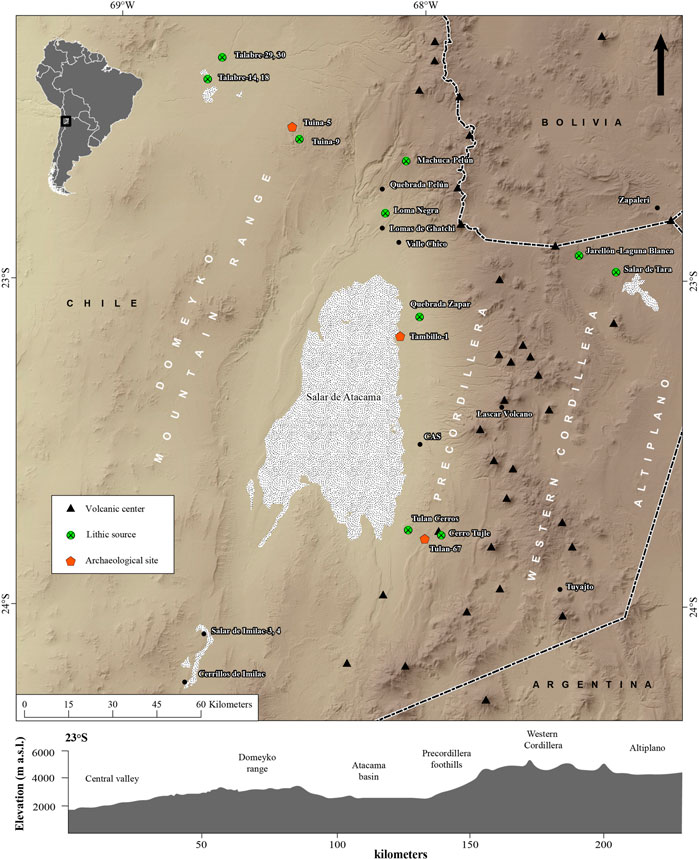
FIGURE 1. Map of archaeological sites studied (red pentagons), lithic raw material sources (green circles), and principal volcanoes of the Atacama basin (black triangles).
3.1 The Domeyko Mountain Range
The Domeyko mountain range in northern Chile runs from north to south with an average altitude of 3,000 m a.s.l. The study area is characterized by mountainous features, pediplanes and alluvial fans (Ramírez and Gardeweg, 1982). The local lithology comprises Upper Carboniferous to Permian ignimbrites and rhyolitic domes, Triassic lacustrine fossiliferous strata, and Cretaceous to Miocene continental sediments (Marinovic and Lahsen, 1984; Mpodozis et al., 2005). To the northwest of the study area, the Cerros de Tuina range is associated with a set of inverse faults (Henríquez et al., 2014).
3.2 The Precordillera Foothills
The Precordillera rises from the low, flat terrain of the Salar de Atacama to the Andes highlands. It presents irregular topography with a slope of 3-5°º, dissected by a dendritic drainage network of ravines up to 200 m deep (Ramírez and Gardeweg, 1982), and by ranges of small hills such as Cas, Peine and Lila hills. Lithologically, it is characterized by outcrops of Paleozoic, Mesozoic and Cenozoic rocks that include sandstones and shales, andesites, dacites, and tuffs (Niemeyer, 2013).
3.3 The Andes Mountain Range
The Andes consists of an imposing mountain range that extends longitudinally from north to south, formed by volcanic features, domes, and hills set on the rhyolitic plateau. In the study area, this unit includes: 1) The Western Cordillera that reaches 6,800 m a.s.l, consisting mainly of Cenozoic volcanic rocks and characterized by a strip of stratovolcanoes overlying older ignimbritic layers (Allmendinger et al., 1997); and 2) the Altiplano or Puna, an extensive ingimbritic plateau that extends through northeastern Chile, Argentina, Peru, and Bolivia at a mean altitude of 4,000 m a.s.l (Isacks, 1988). Locally, the volcanic deposits are formed mainly by ignimbrites, volcanic complexes, and aerial pyroclastic deposits from the Upper Miocene to the Quaternary. The ignimbrites are made up of tuffs of different degrees of welding, mainly dacitic and rhyolitic in composition (Gardeweg and Ramírez, 1985). The stratovolcanoes and stratified volcanic sequences show an andesitic and subordinately basaltic and dacitic composition and, to a lesser extent, pyroclastic cones, domes, and subcircular structures (craters) of rhyolitic composition. Upper pre-Miocene intrusive and folded sedimentary rocks appear in erosion windows and isolated hills (Gardeweg et al., 1998).
4 Materials and Methods
The lithic assemblages studied in this work were recovered from stratigraphic layers of three archaeological sites: Tuina-5, Tambillo-1, and Tulán-67 (Núñez et al., 2002; Núñez et al., 2005) (Table 1). In the first stage, a petrographic classification of the complete archaeological lithic assemblages was carried out. The object of this was to define general groups based on general rock classes and sub-varieties according to variables such as color, texture, granulometry, presence of impurities, and cortex, considering the existing local classifications1,2,3.

TABLE 1. Lithic assemblages studied, by archaeological site, stratigraphic layer, chronology and placement (after Núñez et al., 2005). Radiocarbon dates were calibrated using the ShCal020 curve (Hoggs et al., 2020) in OxCal software.
The second stage consisted of locating and characterizing the raw material sources through directed surveys in the field. The archaeological and geological data of the Atacama basin and its surroundings were consulted to define areas of interest according to the lithologies observed and recognized in the archaeological lithic assemblages. The following data sourced were consulted: Calama sheet (1:250,000) (Marinovic and Lahsen, 1984), Zapaleri sheet (1:250,000) (Gardeweg and Ramírez, 1985), Toconao sheet (1:250,000) (Ramírez and Gardeweg, 1982), Chiu chart (1:50,000) (Blanco and Tomlinson, 2009), Lascar Volcano chart (1:50,000) (Gardeweg et al., 2011), San Pedro de Atacama chart (1:100,000) (Henríquez et al., 2014), Lila-Peine chart (1:100,000) (Niemeyer, 2013). Between 2019 and 2021, various field surveys were carried out and samples were taken from the sources identified. The archaeological artifacts and the geological samples recovered from the lithic procurement sources were compared in the third stage using a magnifying glass (30x) and a Dino-Lite digital microscope (30–250x). Lithological markers - understood as characteristic elements shared by rocks from the same outcrop-were defined that allowed the source of origin to be directly assigned.
5 Results
5.1 Archaeological Assemblages and Lithic Raw Materials
The lithological classification of lithic assemblages identified a wide diversity of rocks, most of them of volcanic and subvolcanic origin, forming a rich and varied lithic assemblage (Figure 2). The main types identified were obsidian, cherts, and other siliceous rocks, andesites and tuffs, in addition to other minorities such as basalts, dacites, pumices, micro-diorites, and granitic and porphyritic rocks, among many others. A count of the rock classes and sub-varieties (with their respective codes used hereinafter) is presented in Table 2. Among the predominant rocks, obsidian was clearly much sought-after, being used mainly in the manufacture of projectile points and micro-perforators (Figures 2A–C). The obsidian class breaks down into several sub-varieties, among which are shiny black (OB-4, Figure 2B), shiny reddish-black (OB-5), translucent gray (OB-1, Figure 2A), and opaque gray (OB-3, Figure 2C). The cherts and silicious rocks comprise several types of rocks but are mostly represented by a white chert with abundant vesicles and rough cortex (SR-1, Figure 2C), a white-yellow siliceous rock (SR-5), and a green epidotized silicified rock (SR-3, Figure 2L). They were used to produce retouched flake-tools and artifacts of various kinds such as end-scrapers, side-scrapers and also bifacial projectile points. The tuffs consist mainly of a red dacitic tuff with white crystals (TF-3, Figure 2E), a gray-cream silicified tuff with black inclusions (TF-7, Figure 2F), a brown andesitic tuff (TF-1, Figure 2m), a greenish brown dacitic tuff (TF-4, Figure 2G), and a devitrified cineritic tuff (TF-2, Figure 2H). The andesites are mostly composed of black hornblende andesites with white crystals (AN-1, Figure 2I), and aphiric black andesite (AN-4, Figure 2J). Another commonly present rock is the gray-pink pumice used in the manufacture of probable containers or mortars (Figure 2K).
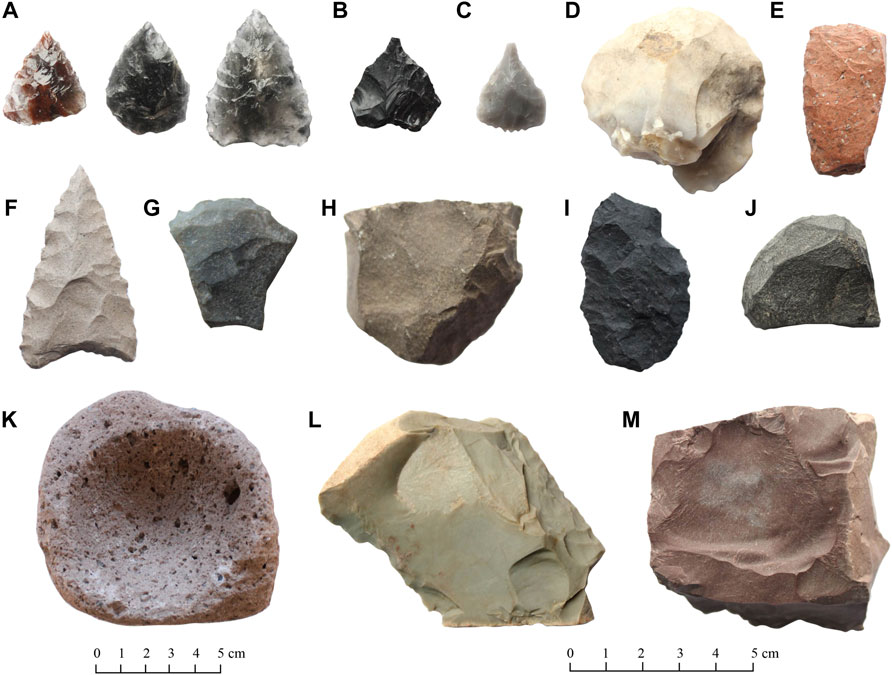
FIGURE 2. Lithic assemblages and raw materials: (A) bifacial projectile points in gray translucent obsidian (Tuina-5 and Tambillo-1); (B) micro-perforator in shiny black obsidian (Tambillo-1); (C) bifacial perforator in opaque gray obsidian (Tulán-67); (D) end-scraper on white chert (Tuina-5); (E) side-scraper on red dacitic tuff (Tambillo-1); (F) bifacial projectile point on gray silicified tuff; (G) retouched flake on greenish ash dacitic tuff (Tambillo-1); (H) core on devitrified brown tuff (Tulán-67); (I) retouched piece on black andesite with crystals (Tambillo-1); (J) end-scraper on black aphiric andesite (Tulán-67); (K) container-mortar on gray-pink pumice (Tambillo-1); (L) retouched flake on epidotized siliceous rock (Tuina-5); (M) core on brown andesitic tuff (Tuina-5).
There are important differences in the frequency of rock classes between sites. In Tuina-5, the predominant rocks are mainly white chert (SR-1), green epidotized siliceous rocks (SR-3) and red dacitic tuffs (TF-3) (Figure 3A). Obsidian is very scarce, occurring only in 31 pieces–all of the translucent gray variety (OB-1) with the exception of one shiny black (OB-4) obsidian flake. On the other hand, a greater diversity of rocks can be observed in Tambillo-1 (Figure 3B): obsidians are abundant, with shiny black (OB-4), translucent gray (OB-1), and opaque gray (OB-3) types predominating. Several varieties of chert, greenish ash tuff (TF-4), brown andesitic tuff (TF-1), and black hornblende andesite (AN-1), among others, were also recorded. Pumice artifacts, granitic rocks, and porphyries are present to a lesser extent. In Tulán-67, devitrified cineritic tuff (TF-2) and chert of the white-yellow (SR-5) variety predominate; there is also a significant frequency of aphiric black andesite (AN-4) and obsidian, particularly the opaque gray variety (OB-3) (Figure 3C).
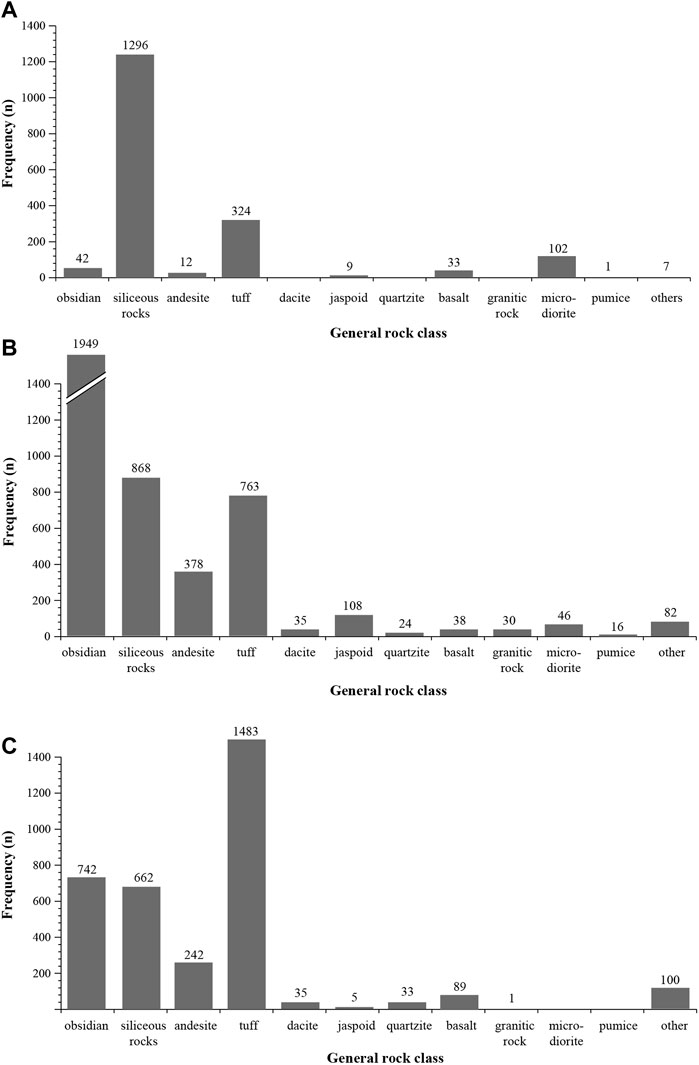
FIGURE 3. Frequency of archaeological artifacts by rock class: (A) Tuina-5 (IV); (B) Tambillo-1; (C) Tulán-67(VII).
5.2. Searching for the Volcanic Lithic Sources of the Atacama Basin
The directed surveys carried out based on geological and archaeological information have allowed us to document 10 lithic raw material procurement sources so far. Among the sources identified, various volcanic geoforms were distinguished: lava flows (Loma Negra-Puripica), volcanic domes and craters (Jarellón-Laguna Blanca and possibly Machuca-Pelún), maars (Cerro Tujle), ignimbrite flows (Quebrada Zapar and Ignimbrites of Filo Delgado), possible hydrothermal deposits (Salar de Talabre-14 and -18) as well as outcrops of continental sequences exposed in hilltops (Cerros de Tuina and Tulán Cerros). Table 3 summarizes the lithic sources and their main characteristics. In all of them, we recorded evidence of primary processing in the form of cores, test blocks, abundant flakes, blades, and in some cases, stone-hammers and retouched tools. Some of them, such as Loma Negra, Cerros de Tuina, Tulán Cerros, and Cerro Tujle, are large quarry-workshop sites formed by extensive anthropic floors of continuous lithic material.
5.2.1 Loma Negra-Puripica
The Loma Negra-Puripica source consists of an extensive lava flow of more than 20 km descending from Sairecabur volcano in a southwesterly direction (Figure 4A). The southern segment corresponds to the Loma Negra quarry initially studied by Gustavo Le Paige (Le Paige, 1958; Orellana, 1962; Le Paige, 1963; Le Paige, 1964; Le Paige, 1970; Agüero, 2005), while the northeastern segment houses the workshops reported near the Puripica archaeological sites (Núñez, 1981; Núñez et al., 1999; 2005). The raw material consists of a dark gray to black hornblende andesite with white crystals (Figure 4B). It comes in the form of large non-transportable blocks up to several meters long, medium-sized blocks, and smaller angular fragments that form a continuous raw material floor (Figure 4C). At the site, an industry of prismatic and pyramidal unidirectional blade cores (Figure 4D) and large flakes predominates, with a few large bifacial pieces. The evidence is concentrated around denser knapping loci and some circular stone structures of the same rock. Geologically, the lava flow is part of the stratum-volcano complex III (Qv) that groups Pleistocene-Holocene volcanoes and lava flows (Marinovic and Lahsen, 1984). The source could be related to the Machuca (4,460 m a.s.l) and Jorquencal (4,971 m a.s.l) stratovolcanoes; and/or to the Falda Grande lava-dome, which could be an ancient emission center (Henríquez et al., 2014).
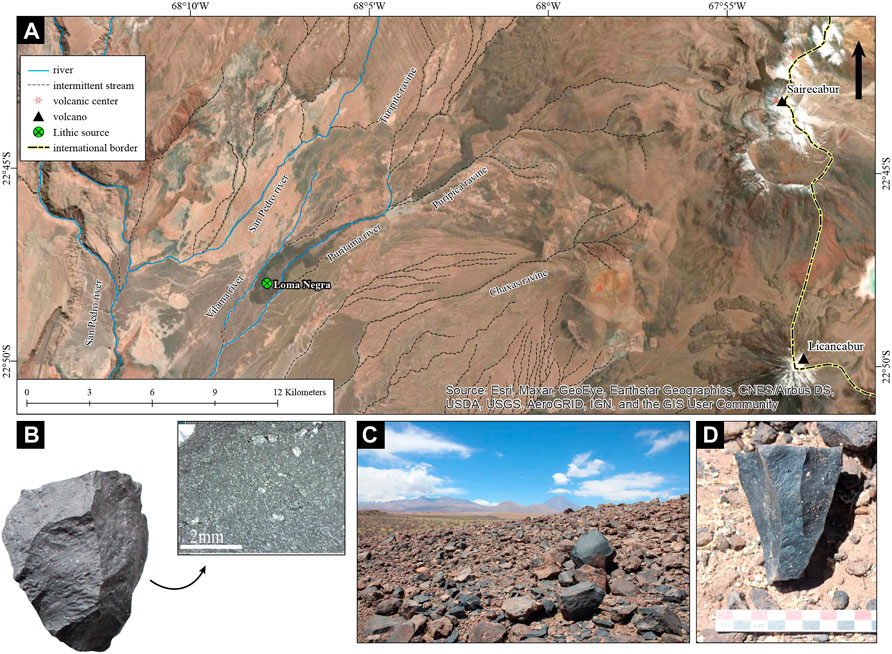
FIGURE 4. Loma Negra-Puripica source: (A) geological context; (B) raw material sample; (C) quarry-workshop site; (D) discarded blade core of black andesite.
5.2.2 Machuca-Pelún
The first descriptions of local obsidian come from surveys carried out by Gustavo Le Paige in Quebrada Pelún (Le Paige, 1964). A secondary source of small nodules was later reported in the lower part of the ravine (De Souza et al., 2002). Other works reported larger nodules at the head of the ravine near the town of Machuca in the highlands, scattered in large areas and also deposited in offerings structures or apachetas on the road (Pimentel, 2008), which were later characterized geochemically by Seelenfreund et al. (2010a). The surveyed area of greatest density was found in a deflated area of 4,000 m2 on the southwestern edge of an ignimbrite outcrop (Figure 5A). Small rounded and sub-rounded nodules of maximum diameter 5–12 cm were observed scattered on the surface. The obsidian is very heterogeneous but with a predominance of translucent gray and translucent brown sub-varieties (Figure 5B). We did not observe dense areas of primary processing in the form of quarry workshops, except for very scattered, isolated evidence of knapping. The source appears to be spatially associated with an ignimbrite outcrop (Figure 5C) of the Puripica Formation (Guest, 1969; Henríquez et al., 2014).
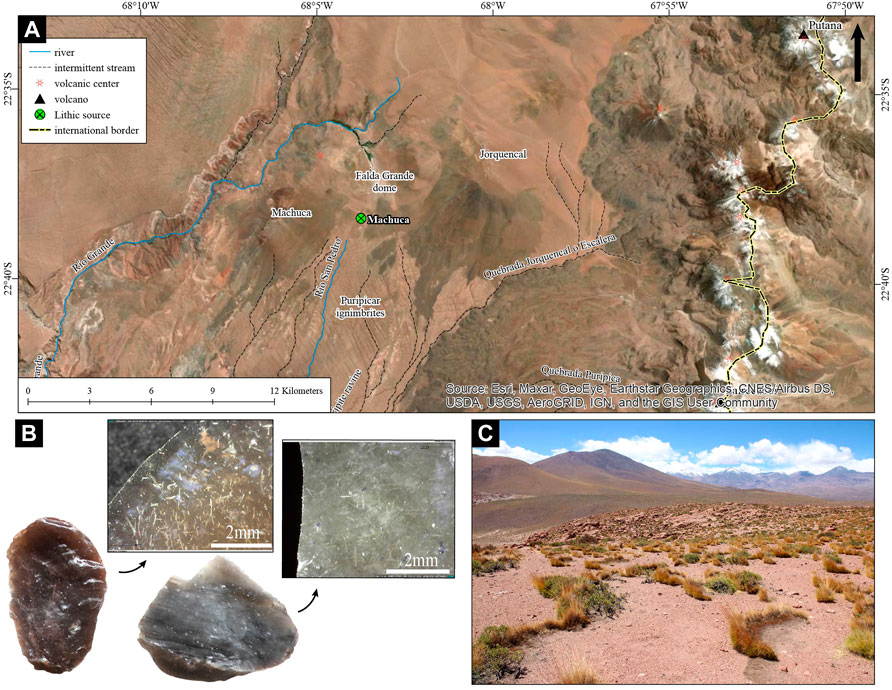
FIGURE 5. Machuca-Pelún source: (A) geological context; (B) raw material samples; (C) scatter area of raw materials.
5.2.3 Jarellón-Laguna Blanca and Salar de Tara
The Jarellón-Laguna Blanca obsidian source was first described by Seelenfreund et al. (2010b) as a primary source located on the slope of a collapsed caldera (Figure 6A). Geologically, the formation comprises dacitic and rhyolitic lavas (Gardeweg and Ramírez, 1985:63). Some interpretations suggest that the caldera formed due to a plinian eruption, which led to its collapse and the subsequent formation of the caldera (Seelenfreund et al., 2010b). Obsidian is available in eroded nodules of between 8 and 22 cm (Figure 6B) and blocks up to 70 cm near the flow edge of the northeast dome. Several knapping loci, stone parapets, and non-local obsidian offerings were recorded in the area (Seelenfreund et al., 2010b). A secondary source was also reported on the northwest edge of the Salar de Tara, located on a beach of lacustrine sedimentation (Seelenfreund et al., 2010a) (Figure 6A). We recorded several lithic scatters with abundant flakes, cores on natural nodules and bifacial projectile points on local obsidian. We sampled two areas to the northeast of the Hualitas volcano and recorded round nodules of shinny black and reddish-black obsidian (Figure 6C). We found slight evidence of exploitation in some lithic scatters associated with ephemeral stone structures. The obsidian nodules could be secondary transport from the Jarellón source, or could be related to the Hualitas stratum-volcano (5,010 masl) (Gardeweg and Ramírez, 1985).
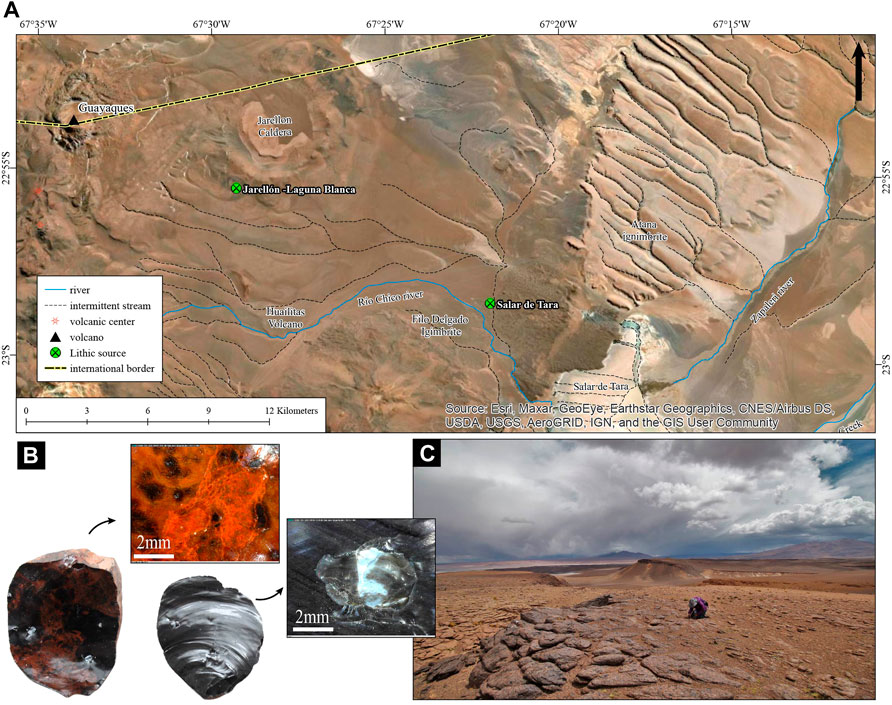
FIGURE 6. Jarellón-Laguna Blanca source: (A) geological context; (B) raw material sample; (C) scatter area of obsidian samples.
5.2.4 Cerro Tujle
The Cerro Tujle source is a large quarry-workshop around a small volcanic crater 300 m in diameter and 70 m deep (Figure 7A). It was previously described as a meteorite crater (Ferrando, 1977), but later characterized as a maar-type volcanic crater produced by a phreatic-magmatic eruption (Ureta et al., 2018; Ureta et al., 2020a; Ureta et al., 2020b). The raw material occurs in large blocks and smaller angular fragments of black andesite available around the tephra ring (Figure 7B). At the site, we observed many test blocks, cores, flakes, and especially large blades, and some bifacial pieces (Figure 7C). The formation was included within the set of stratum-volcanoes III of the Quaternary (Ramírez and Gardeweg, 1982).
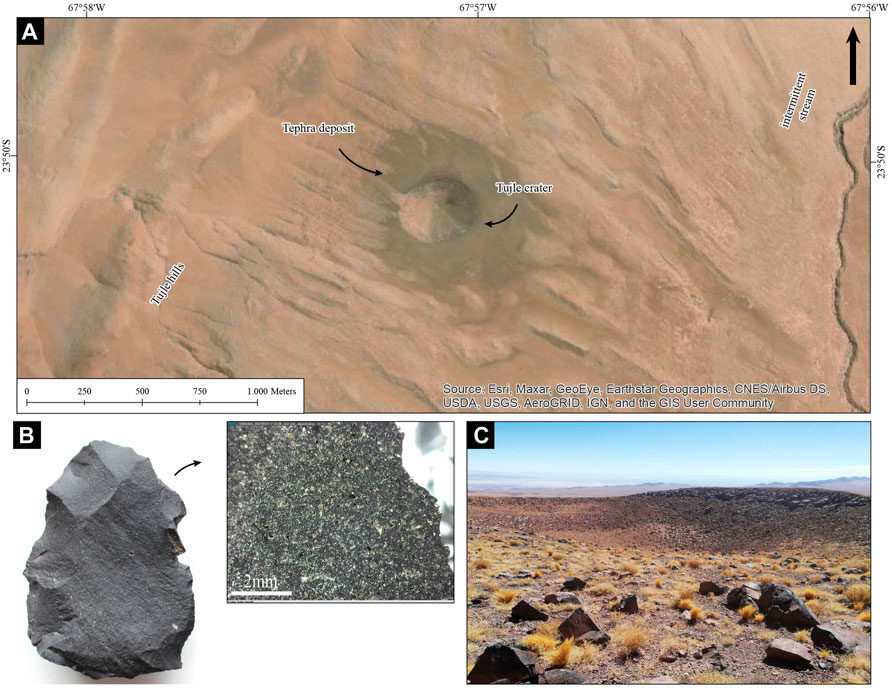
FIGURE 7. Cerro Tujle source: (A) geological context; (B) raw material sample; (C) quarry-workshop site near to the crater border.
5.2.4 Quebrada Zapar
On the eastern edge of Quebrada Zapar (Figure 8A), we found large, superficially scattered pumice fragments of up to 30–40 cm (Figure 10B). The fragments are of round and tabular morphology and consist of grey-pink pumice of dacitic composition (Figure 8C). The source would be linked to the Ignimbrite Cajón Formation (Pc) (Guest, 1968), which includes several levels of tuffs characterized by banded pumice (Henríquez et al., 2014). According to Marinovic and Lahsen (1984), the ignimbrite flows were emitted in a short period; they were attributed to the Purico volcano (5,703 masl) emission center, 30 km east of the site.
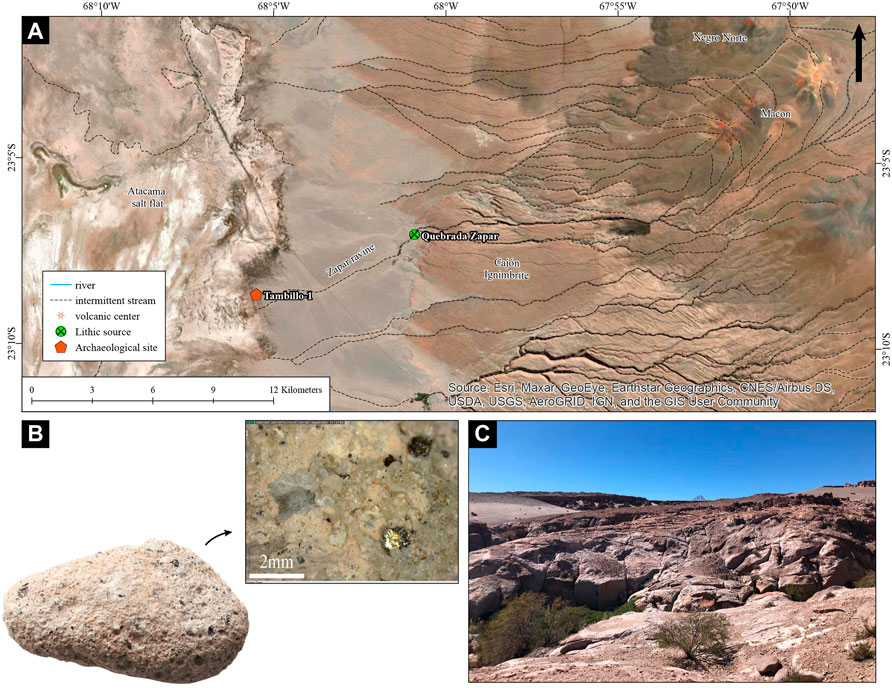
FIGURE 8. Quebrada Zapar Source: (A) geological context; (B) pumice sample; (C) Zapar Ravine outcrops.
5.2.5 Tulán Cerros
Tulán Cerros consists of a large area north of Quebrada Tulán (2,850 masl), where veins form outcrops on top of the numerous hills of the landscape. More than 30 quarry-workshop sites have been reported in the upper part (Le Paige, 1964; Le Paige, 1970; Núñez, 1983) and several lithic scatters of the same raw material have been recorded in nearby areas (Barfield, 1969; Niemeyer and Schiapacasse, 1976) (Figures 9A,B). In recent surveys, we documented many quarry-workshop sites of variable extension where an industry of large bifaces, flakes, and blades predominates (Figure 9C). We observed lithic mortars on the surface, stone structures, and engraved plaquettes in some places. The raw material appears in erosion heights in the form of diaclassic blocks between 20 and 60 cm of green, reddish, brown, and light brown devitrified tuff (Loyola et al., 2016). The outcrop is probably related to the middle member of the Cerros Negros Formation (Pcn) (Niemeyer, 2013).
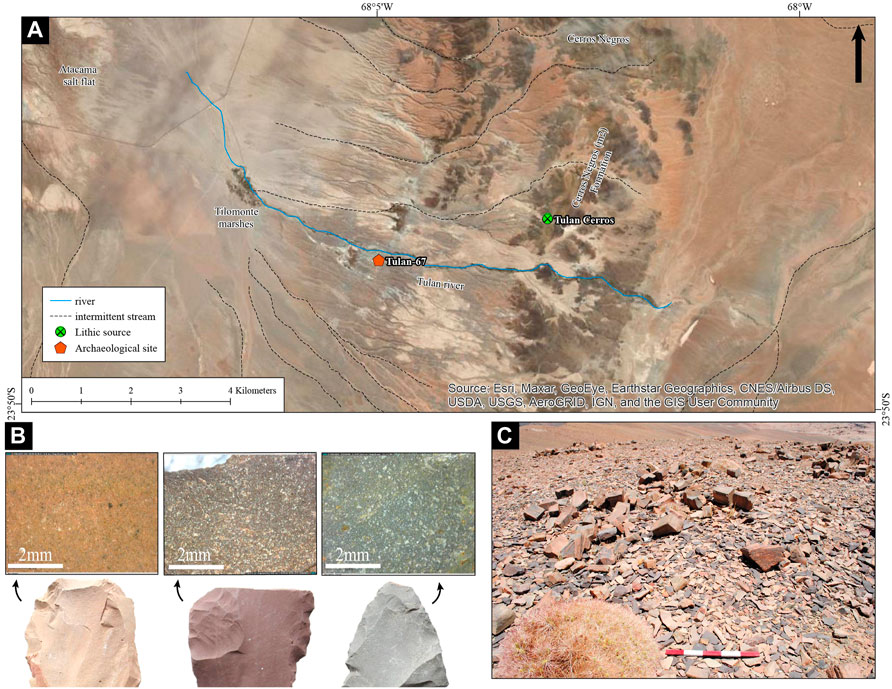
FIGURE 9. Tulán Cerros source complex: (A) geological context; (B) raw material samples; (C) Tulán Cerros-2 quarry-workshop site.
5.2.6 Salar de Talabre
The Salar de Talabre lithic workshops have been extensively studied (Le Paige, 1964; Lanning, 1967; Núñez 1967; Lanning, 1968; Lanning, 1970; Le Paige, 1970; Núñez 1983) (Figure 10A). The raw materials have been described as silicified tuff (Lewis-Johnson 1978) or vitreous rhyolitic tuff (Barfield, 1960), silicified limestone, and low-grade chert (Meltzer 1979). The Talabre-29 and 30 sites to the north of the basin (Figure 10B) consist of large open-air quarry-workshop sites on a plain where blocks and fragments of 20–40 cm of silicified gray, often cream, tuff form outcrops (Figure 10C). Geologically, the site is located in the Upper Miocene-Upper Pliocene Opache Formation (MPo) (May et al., 2005; Blanco and Tomlinson, 2009). Some early work suggested that tuff formations originated from incandescent ash-falls on wet surfaces, probably lakes or swamps (Meltzer, 1979). The Talabre-14 and Talabre-18 quarry-workshops are located on the southeast margin of the current Talabre salt flat. In Talabre-14 (Figure 10D), we documented abundant evidence of knapping on waste-flakes and nodules of a white siliceous rock and beige chalcedony with significant impurities, vesicles, and very rough cortex (Figure 10E). In Talabre-18, large, semi-buried blocks of white chert of fair and mediocre quality were observed. The chert composition suggests a sedimentary origin, with possible recrystallization by low temperature hydrothermalism, but more studies are needed. Geologically, both sites are located in the Talabre Member (Ml2) of the Lasana Formation (Middle Miocene-Lower Upper Miocene) (Blanco and Tomlinson, 2009).
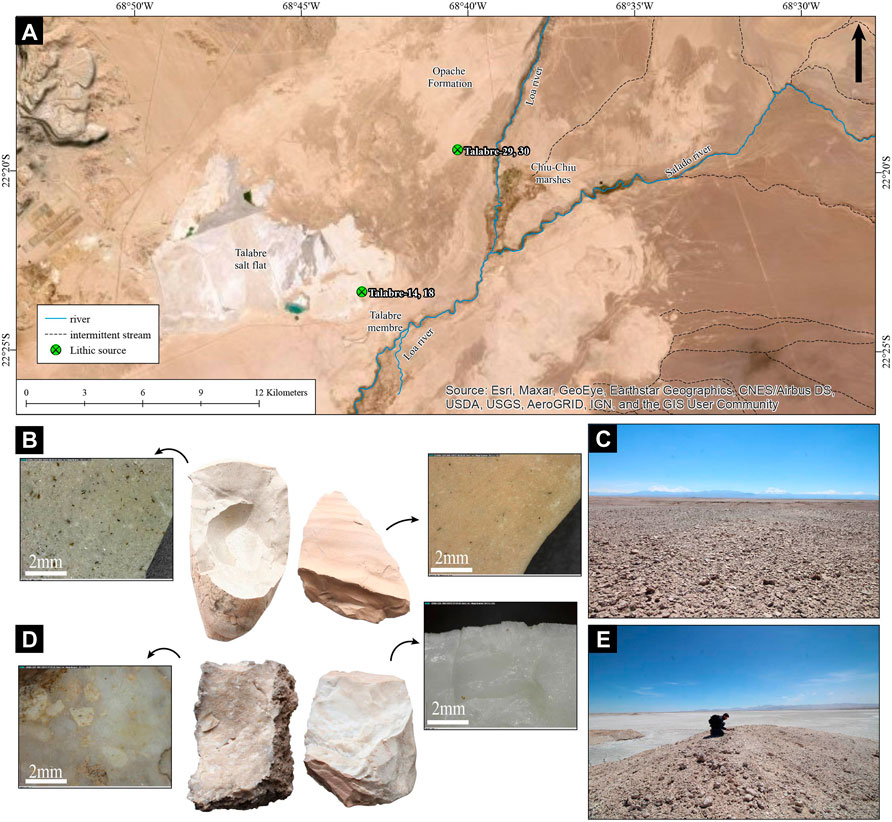
FIGURE 10. Salar de Talabre source complex: (A) geological context; (B) raw material samples from Talabre-29 (left) and Talabre-30 (right) sites; (C) Talabre-30 quarry-workshop site; (D) raw material samples from Talabre-14 (right) and Talabre-18 (left) sources; (E) quarry-workshop site of Talabre-14.
5.2.7 Cerros de Tuina (Tuina-9)
Tuina-9 consists of a workshop-quarry on the southern slope of Morro del Inca (3,608 masl) in the Tuina Mountain range (Figure 11A), where we find the most significant number of flakes and cores, and two stone structures. Diaclassic fragments and medium-sized plaquettes (20–40 cm) of an green epidotized siliceous rock are very abundant at the site (Figure 11B). We also documented a brown andesitic tuff in larger blocks (Figure 11C). The source seems to be related to the Lower Member of the Tuina Formation (PeTrt1) from the Upper Permian-Middle Triassic, mainly volcanic, consisting of andesites with frequent epidotization (Figure 11D) (Henríquez et al., 2014).
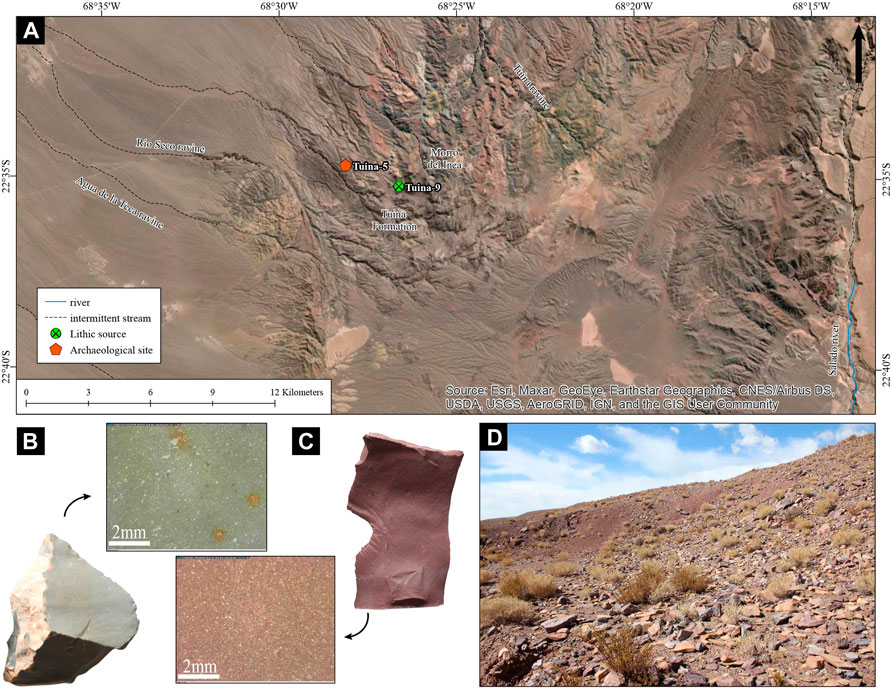
FIGURE 11. Cerros de Tuina: (A) geological context; (B) raw material samples; (C) raw material samples; (D) Tuina-9 quarry-workshop site.
5.3 Identification of Lithic Raw Materials: Linking Sites and Sources
By comparing the archaeological artifacts with the raw material samples taken in the field we were able to assign the procurement sources. Table 4 summarizes raw material assignments based on the recognition of the lithological markers defined in the geological samples. Figure 12 shows the appearance of each variety at 50x. The shiny black obsidian (OB-4, Figure 12A) and reddish-black variety (OB-5, Figure 12B) was assigned to the Salar de Tara and Jarellón-Laguna Blanca sources, although it is impossible to separate them as they have the same geochemical signature and an identical visual appearance under the microscope. Together with the Zapaleri source (Yacobaccio et al., 2004), Jarellón-Laguna Blanca and Salar de Tara would form a homogeneous group of obsidian sources related to the same magmatic system (Seelenfreund et al., 2010a). In the case of Machuca-Pelún obsidian, two main sub-varieties were distinguished: OB-1 (Figure 12C) and OB-2 (Figure 12D) while the aphiric black andesite (AN-4, Figure 12E) corresponds to the Cerro Tujle maar. The devitrified cineritic tuff (TF-2, Figure 12F) in its three varieties (brown, light brown, and green) corresponds to the Tulán Cerros source complex. The green epidotized silicified rocks (SR-3) come primarily from the Tuina-9 source (Figure 12G), as does the brown andesitic tuff (TF-1, Figure 12H). The gray-cream silicified tuff (TF-7, Figure 12I) corresponds to the source of Talabre-29, 30. Among the wide variety of cherts, a good part of the white chert (SR1-1, Figure 12J) could be assigned to the Talabre-14 and 18 sources. The pumice, recorded in the Tambillo-1 site, was easily assigned to the Zapar source (Figure 12K) and the black hornblende andesites (AN-1, Figure 12L) are related to the Loma Negra-Puripica source.
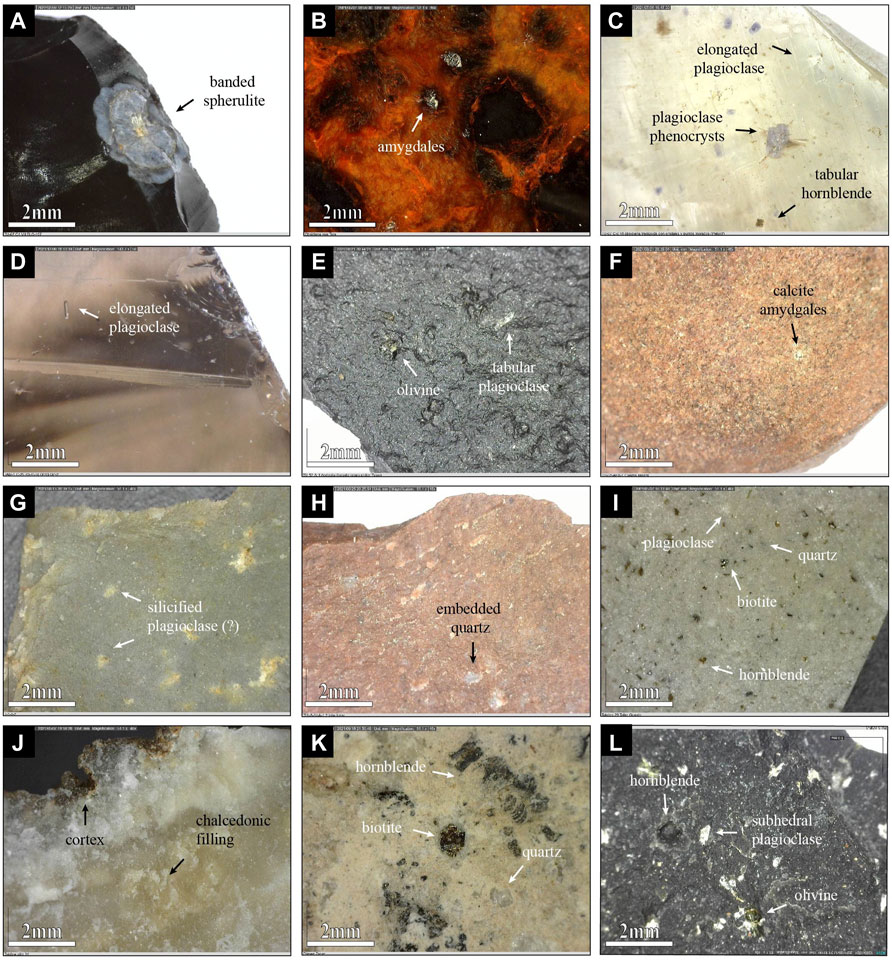
FIGURE 12. Raw materials from known sources: (A); shiny black obsidian (OB-4); (B) Shiny reddish-black obsidian (OB-5); (C) translucent gray obsidian (OB-1); (D) translucent brown obsidian (OB-2); (E) Aphiric black andesite (AN-4); (F) devitrified cineritic tuff (TF-2); (G) green epidotized silicified rock (SR-3); (H) brown andesitic tuff (TF-1); (I) gray-cream silicified tuff (TF-7); (J) white chert (SR-1); (K) gray-pink pumice; (L) black hornblende andesite (AN-1).
Some lithic raw materials from unknown sources can be attributed to a local origin. The source of the opaque gray obsidian (OB-3, Figure 13A), recognized by its high content of hornblende and biotite, could be found near the Tulán ravine due to its higher frequency in Tulán sites. We also suspect that the black-red shiny obsidian (OB-6) with large grey amygdales (Figure 13B) comes from the Lascar volcano area (see Figure 1). Other obsidian pieces come from allochthonous sources in northwestern Argentina, as confirmed by XRF and NAA analyses (Loyola, 2020). The translucent obsidian (OB-8) shows reddish oxidized biotite crystals with a hexagonal shape (0.1–0.3 mm) that match with Salar del Hombre Muerto source (Figure 13C); while Ona-Las Cuevas obsidian presents characteristic fluid inclusions with biotite and oxidation (Figure 12D) and tabular hornblende crystals (Figure 12E) that match with our OB-7. Some few pieces of translucent obsidian with black inclusions (OB-9) of developed tabular hornblende (Figure 12F) come from the Alto Tocomar source in Salta, Argentina (see Yacobaccio et al., 2004). Two varieties of siliceous rocks–brown with reddish spots (SR-6, Figure 12G) and white with spots with dendritic habit (SR-4, Figure 13H) – were reported that would come from north of the Imilac basin (Cartajena et al., 2014; Loyola et al., 2019b). The source of the red dacitic tuff with white crystals (TF-3, Figure 13I) is also unidentified, but judging by its frequency it could be available at different points of the eastern border of the Atacama basin; it is most frequently found in archaeological sites near Tambillo and Aguas Blancas ravine (see Figure 1). The white-yellow siliceous rock (SR-5, Figure 13J) could come from a source located 5 km south of Tulán (Yacobaccio and Núñez, 1991). The pink tuff (TF-6, Figure 13K) is less abundant but probably comes from Cerros de CAS as well as a part of the gray basalt (Le Paige, 1970, see Figure 1). A common variety is a dark andesite with tabular hornblende crystals (AN-6, Figure 13L), the source of which is still unknown but presumably local. Finally, comparisons with museum collections make us think that the greenish brown dacitic tuff (TF-4) would come from the Lomas de Ghatchi (Le Paige, 1960; Le Paige 1963; Le Paige 1964) while the black pyroxene andesite (AN-3) is frequent in the quarry-workshops of Valle Chico ravine (Le Paige and Serracino 1974) (see Figure 1).
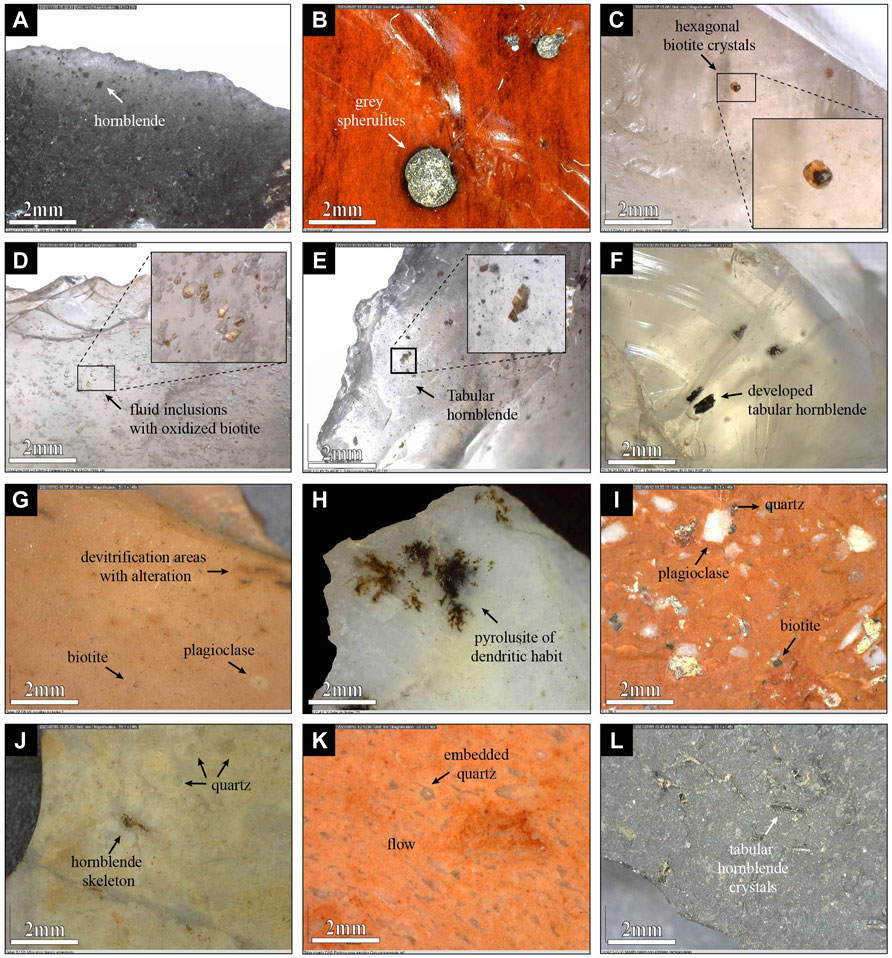
FIGURE 13. Lithic raw materials from unknown and extra-local sources: (A); opaque gray obsidian (OB-3); (B) Shiny black-red obsidian (OB-6); (C) translucent obsidian (OB-8); (D) translucent obsidian with fluid inclusions (OB-7); (E) translucent obsidian with inclusions (OB-7) (F) translucent obsidian with black inclusions (OB-9); (G) Brown siliceous rock with reddish spots (SR-6); (H) white chert with black spots (SR-4); (I) red dacitic tuff with white crystals (TF-3); (J) white-yellow silicified rock (SR-5); (K) Pink tuff whith flow (TF-6); (L) Black andesite with tabular hornblendes (AN-6).
6 Discussion
6.1 The Exploitation of Volcanic Rocks Among Early Andean Hunter-Gatherers
Analysis of the archaeological assemblages of Tuina-5, Tambillo-1, and Tulán-67 revealed that during the Early Archaic period, stone tools and other lithic objects were made from a wide variety of lithic raw materials of volcanic and subvolcanic origin. Such variability accounts for the use of rocks with different properties and qualities, from the sharpest and best quality, such as obsidian and siliceous rocks, to the most tenacious and resistant, such as andesite, tuffs and basalts, and even others as granite and pumice. Each of these rock classes seems to have been intended for particular categories of tools and objects, production of which required the application of specific know-how and knapping techniques, depending on its particular properties (see Nami, 2015).
However, several factors hindered lithological classification. One of them is the thermal alteration that introduces a series of physical-chemical changes in the artifacts that inhibit their identification, such as luster, rubefaction, calcination, cracking, plotids, and thermal fractures. Heat treatment is a technique widely used in prehistory to improve the quality of knappable rocks through controlled exposure to fire. However, thermal alterations can also result from accidental exposure to fire-pits or natural fires (Inizan and Tixier, 2000). In the sites, thermal alteration of lithic assemblages reaches 1,91% in Tambillo-1 (n=93), 0,82% (n=16) in Tuina-5 and 7,47% (n=247) in Tulán-67. Moreover, it is impossible at present to be sure whether this alteration is due to an intentional process to improve the quality of the raw material or is the involuntary result of exposure to heat sources, such as the several hearths documented at the sites. Further study is needed to explore how thermal alterations expressed in each of the raw materials. On the other hand, assignment was also limited by the high fragmentation or small size of the samples: in some cases, the maximum length of the artifacts analyzed, such as pressure-retouching flakes, was no more than a few millimeters, preventing the conservation of lithic markers and other diagnostic features such as the cortex.
This high diversity of lithic raw materials probably reflects deep knowledge not only of the volcanic landscape and its rocks, but also the techniques necessary to work them. The exploitation of lithic resources among hunter-gatherers in the Atacama basin and adjacent basins has been addressed in various works (Le Paige, 1970; Serracino, 1975; Núñez et al., 2002; Loyola et al., 2021, among others). Judging by the descriptions and the availability of raw materials in the landscape, volcanic rocks have been a constant in Andean hunter-gatherer societies due to their wide availability and easy access, especially in high-altitude environments where their use persisted in later periods. The data obtained in this work suggest that human groups early integrated these resources into their social, economic, and technological sphere, developing a deep knowledge of their properties and characteristics. The application of technological and functional studies currently in progress will offer better understanding of raw material management, production techniques, and contexts of use.
6.2 The Procurement of Volcanic Rocks and the Lithic Sources
The procurement sources identified offer a first approach to the accessibility and availability of lithic resources in the Atacama basin. Several of these sources had been detected and characterized in different works dating back to the 1960s (Lanning, 1967; Lanning, 1968; Le Paige, 1970; Le Paige and Serracino, 1974; Núñez, 1983; Seelenfreund et al., 2010a; Seelenfreund et al., 2010b; Loyola et al., 2016); however, these works pursued other objectives and used different methodologies. Lithic studies of archaic sites have focused instead on understanding the technological management of resources and mobility patterns at site scale; we have little knowledge about sources of provenance. Conversely, there are several geochemical analyses and field characterizations in the case of obsidian (Seelenfreund et al., 2010a; Seelenfreund et al., 2010b) but with little application to early periods.
Our field surveys identified several lithic sources in the Atacama basin distributed in a vast and contrasting landscape ranging from 2000 to 4,500 m a.s.l. The sources detected are almost entirely volcanic and subvolcanic formations, such as lava flows, maars, craters, caldera-domes, ignimbrite flows, hydrothermal deposits, and outcrops of volcanic facies formed in different geological epochs. Each of them provides various kinds of rock. We documented large quarry-workshop sites in several of these places, with knapping evidence indicating intense and repeated human activity over several periods. The Loma-Negra and Puripica quarry-workshops are extensive areas of discarded material forming a continuous floor of lithic material, including stone structures. In Tulán Cerros, engraved plaquettes and blades have been recorded at the quarry-workshop sites; these provide evidence of symbolic practices (Figures 14A,B), although their chronology has not yet been well specified. Another exceptional engraved volcanic tuff was recovered from the initial occupation floor of Puripica-1 dated to 4,815 + 70 BP (5,651–5,320 cal BP) (Figure 14C), with one of the first manifestations of rock art in the area (Núñez, 1981; Núñez, 1983). The quarry-workshops of the Salar de Talabre are of medium intensity, but with an intense deposition of lithic materials. A similar pattern is found at Cerro Tujle, where the knapping activities were organized around the crater. The absence of evidence of exploitation in the Machuca-Pelún, Salar de Tara and Jarellón-Laguna Blanca sources is probably due to the greater dispersion of the raw material and to the fact that the nodules were collected and transported directly after being tested. Something similar could have happened in the case of the pumices that did not leave observable evidence of production.
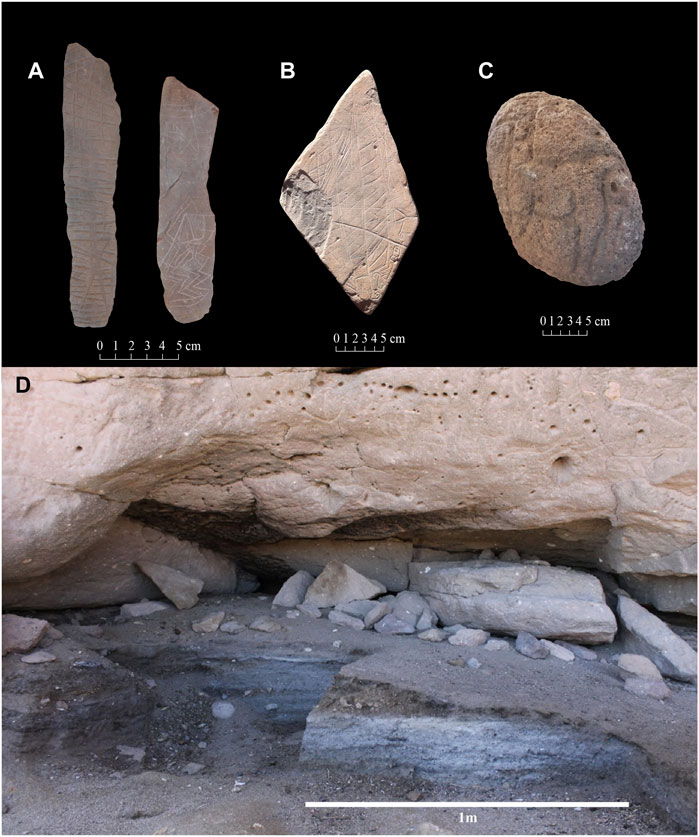
FIGURE 14. Engraved lithics on volcanic rocks: (A) engraved blades with geometric motifs on devitrified cineritic tuff (Tulán Cerros-2 site); (B) engraved plaquettes from Tulán Cerros in devitrified cineritic brown tuff (collection of Gustavo Le Paige); (C) volcanic tuff with engraved camelid motif recovered from the initial occupation floor of the Puripica-1 site (Núñez 1983); (D) Late Early Archaic occupation in ash stratigraphic layer (light gray): site Tulán-109 (Núñez et al., 2005).
The volcanic landscape of the Andean Puna provides a rich and diverse supply of lithic raw materials; however, these rocks are differentially available from limited sources, scattered throughout an arid and mountainous landscape. Human groups quickly integrated volcanic formations and their distribution into their cognitive maps; the archaeological evidence indicates that the sources were stable and recurrent nodes within the seasonal mobility cycle. These were not only spaces where hunter-gatherers carried out extractive activities, but were also occasions for social interaction and transmission of technical knowledge. Among early hunter-gatherers, obsidian appears to have been one of the most appreciated raw materials. The wide availability and distribution of obsidian allowed human groups to provision directly, both during their seasonal occupation of the highlands and from secondary sources on lower floors. This behavior persisted in societies that adopted agro-pastoralist ways of life in later periods. Thus, obsidian and other rocks continued to circulate and be exchanged over great distances (Berenguer, 2004; Yacobaccio, et al., 2004; Núñez, et al., 2007; Escola et al., 2016; Loyola et al., 2021).
6.3 The Volcanic Landscapes of the Early Hunter-Gatherers
By comparing the archaeological assemblages with samples collected in the field, potential sources of origin could be assigned to the lithic raw materials. This allows us to track the circulation of raw material between different microenvironments such as the Domeyko mountain range, the Precordillera foothills, the Altiplano, and even the eastern slope of the Andes. After a first evaluation, it can be suggested that the frequency of each raw material in the assemblages is directly related to the distance from its source. The lithic landscape, understood as the physical distribution and availability of rock resources (Gould and Saggers, 1985), offers a wide diversity of resources over variable distances. Most of the lithic raw materials come from sources in the immediate surroundings of the sites, whereas raw materials from more distant sources are transported to the settlements in smaller amounts and volumes. This differential distribution of raw materials can be directly related to the techno-economic zoning of the landscape. Sources in the immediate surroundings of the sites (<5 km) could be exploited as part of daily activities within the foraging area. The redundancy and intensity of activities in these spaces allowed the formation of large quarry-workshop sites such as Loma Negra, Tulán Cerros, and Cerros de Tuina. On the other hand, raw materials from more distant local sources (5–40 km), had to be supplied through other mechanisms; for example, through inter-settlement transport, within the seasonal mobility circuit, or even through specific logistical trips, leaving little evidence in situ, as is the case of Machuca-Pelún and Salar de Tara and Jarellón-Laguna Blanca. Rocks of allochthonous origin, especially trans-Andean obsidian, may have been obtained in smaller volumes by exchange or some other type of long-distance interaction.
The relationship between past societies and volcanism has generally been approached through the risk and impact of eruptive events (Torrence et al., 2000; Grattan et al., 2002; Shimoyama, 2002; Torrence and Grattan, 2002; Vanderhoek and Nelson, 2007; Torrence, 2014). In the Andes, a correlation between cultural changes and volcanic explosions in recent periods has been suggested (Bouysse-Cassagne and Bouysse, 1984; Pärssinen, 2015); however, we know little about early hunter-gatherer societies (Grosjean et al., 2007). Some works have discussed the consequences of volcanic events during the demographic bottleneck of the Middle Holocene period (Durán and Mikkan, 2009), and their effects on interaction networks and social organization (Aschero, 2016). Several catastrophic events and eruptions have occurred during the long sequence of human occupation in the Atacama Basin; in fact, volcanic ash layers interspersed with human occupations have been reported in Tulán-109 (2,900 m a.s.l) (Figure 14D), San Lorenzo-1 (3,000 m a.s.l), Tuina- 1 and -3 (3,000 m a.s.l), Miscanti-1 (4,200 m a.s.l) and Tambillo-6 (2000 m a.s.l), among others (Núñez et al., 2005; Núñez et al., 2018) but they have not yet been adequately studied. The Tulán-54 site, one of the oldest ceremonial centers in the region, was built on a dense layer of volcanic ash (Núñez et al., 2017). Local geological research has reported large-scale eruptions that could have formed the ash layers at archaeological sites. This is the case of the Tumbres eruption (9,100–9,300 cal BP), which produced an andesitic pumice fall deposit and a pyroclastic flow that extended for more than 10 km (Gardeweg et al., 1998). Likewise the Socompa devastating eruption (6,051 m a.s.l) produced a massive debris avalanche (7,200–6,200 cal BP) that extended for 40–50 km (van Wyk de Vries et al., 2001; Davies et al., 2010) with an ash fall area whose extent is still unknown. In the Argentine northwest, several Pleistocene and Holocene volcanic ash deposits have been reported, in some cases more than 4 meters thick (Fernández-Turiel et al., 2012).
These events must have occurred contemporaneously, and must have impacted early human societies not only through their direct consequences. Records of eruptions can persist for centuries in collective memory and oral tradition in the form of myths (Fox Hodgson, 2007). However, it has been argued that hunter-gatherer societies have a greater degree of resilience and tend to recover quickly from the sudden stress of explosive eruptions (Sheets 1999; Sheets, 2001). Volcanoes seem rather to have been recurrent nodes of interaction and mobility within the mobility cycle, and sources of raw materials from which to manufacture objects–not only tools for subsistence but also goods with a social and symbolic value, as in the case of rock art on ignimbrite formations (Núñez et al., 2017); obsidian projectile points were exchanged over great distances and deposited as offerings in ceremonies among late hunter-gatherers and early pastoralist groups (Loyola et al., 2020). Considering the continuity in the exploitation of these sources in later periods, knowledge of the landscape and its rocks must have been stored in oral tradition and shared cognitive maps in the long-term. It is therefore reasonable to suppose that this same knowledge probably laid the foundations for the development of the copper mining and lapidary technologies, for which the societies of the Atacama were widely recognized until recent times (Figueroa et al., 2013; Sapiains et al., 2022).
7 Conclusion
Andean societies developed and maintained a close relationship with volcanoes and high mountains from the beginning of peopling of the region in ancient times. Study of the lithic assemblages of three sites dated between 11,500 and 9,500 cal BP revealed the procurement and circulation of a wide variety of volcanic and subvolcanic rocks. These rocks were obtained from different formations and landforms, reflecting the high level of volcanism in the region both in the distant past and more recently that has modeled a steep relief with strong altitudinal contrasts. In these sites we also documented large quarry-workshop sites and even residential camps, evidence of the intensity of past human activities and their role within mobility and interaction networks.
The relationship between archaeological sites and procurement sources allows us for first time to trace the routes and distances traveled by individuals and groups during their daily activities and interactions in these landforms. From usual movements in the surroundings of the settlements or their seasonal displacements to the highlands, to the long-distance trips to the eastern slope of the Andes. Within these circulation networks at different scales, volcanoes were important nodes for their activities and movements. As it happens today, 10,000 years ago the volcanic features probably were already a fundamental part of the way of life of Andean societies in different dimensions–as sacred deities, economic resource areas, geographical and calendar markers, ritual settings and even recurrent habitats. Beyond the catastrophic consequences of eruptions, the andean societies and volcanism converge in still active and ancient “volcanic landscape”, and the lithic record constitutes an exceptional archive of these social relations.
Data Availability Statement
The original contributions presented in the study are included in the article/supplementary material, further inquiries can be directed to the corresponding author.
Author Contributions
The authors contributed in the following areas: RL: research conception and planning; laboratory analysis; field study; general writing of the article. VF: Conception and research design; field work surveys and general writing of the article. Field coordination and logistics. LN: Theoretical-methodological development of the archaeological research; participation in field work and general drafting of the manuscript. MaV: Field work (source sampling) and laboratory analysis (study of geological samples). CE: Field work and anthropological-archaeological background analysis for the preparation of the manuscript. Logistics and planning in the field. MiV: Methodological development; direction of the analysis of samples in the laboratory; theoretical corpus and developement of the geological background. MP: Conception and research design; carthograpy; environmental contextualization; graphic work and editing of the manuscript.
Funding
Funding for fieldwork and analysis was made possible by Wenner-Gren Dissertation Fieldwork Grant 3770214982, Fondecyt 1201603, and ECOS C19H05.
Conflict of Interest
The authors declare that the research was conducted in the absence of any commercial or financial relationships that could be construed as a potential conflict of interest.
Publisher’s Note
All claims expressed in this article are solely those of the authors and do not necessarily represent those of their affiliated organizations, or those of the publisher, the editors and the reviewers. Any product that may be evaluated in this article, or claim that may be made by its manufacturer, is not guaranteed or endorsed by the publisher.
Acknowledgments
First of all, we would like to acknowledge that this research was conducted on the traditional lands of the Lickanantay People. Also, we thank the Instituto de Investigaciones Arqueológicas y Museo (IIAM-UCN) that sponsored this research. We thank the Comunidad Atacameña de Toconao (CAT) who provided us with field and logistical support during this research as part of the associative research agreement between CAT and IIAM. Special thanks to Jimena Cruz, Macarena Oviedo, Luciano Oviedo, and Pamela Cruz for the management of lithic collections. We thank the Comunidad Atacameña de Toconao especially the Presidents Yermin Basques (2019–2020), and Luzvenia Catur (2021–2022). Finally, we would like to thank to Dr. Thérèse Bouysse-Cassagne and Dr. Philippe Bouysse, whose pioneering work on Andean volcanoes, conversations and contributions inspired this work.
Footnotes
1Grosjean, M. 2003. Introduction to rock and mineral classification: a manual for archaeologist with an emphasis on the Atacama Desert, Chile. San Pedro de Atacama: Fondecyt 1020316. (Unpublished Report).
2Lau-Milla, R. 2007. Metodología y aplicación de geoarqueología para la caracterización litológica de sitios arqueológicos de la II Región. Antofagasta: Universidad Católica del Norte. Unpublished thesis.
3Vasquez, M. 2021. Caracterización y Procedencia de Materias Primas Líticas en sitios arqueológicos del Periodo Arcaico: Una Aproximación Geo-Arqueológica a los Paisajes Líticos del Desierto de Atacama. Antofagasta: Universidad Católica del Norte. Unpublished tesis.
References
Agüero, P. C. (2005). Aproximación al asentamiento humano temprano en los oasis de San Pedro de Atacama. Estud. Atacam. 30, 29–60. doi:10.4067/S0718-10432005000200003
Allmendinger, R. W., Jordan, T. E., Kay, S. M., and Isacks, B. L. (1997). The Evolution of the Altiplano-Puna Plateau of the Central Andes. Annu. Rev. Earth Planet. Sci. 25, 139–174. doi:10.1146/annurev.earth.25.1.139
Alonso, H., and Risacher, F. (1996). The Salar de Atacama Geochemistry, part 1: The origin of components and saline balance. Rev. Geol. Chile 23 (2), 113–122. doi:10.5027/andgeoV23n2-a01
Aschero, C. (2016). Cazadores-recolectores, organización social e interacciones a distancia. Un modelado del caso Antofagasta de la Sierra (Catamarca, Argentina). Mundo Antes 10, 43–71.
Barfield, L. (1969). A Primitive Stone Industry from Tilomonte. Prov, Antofagasta. B Mus Nac Hist. Nat 69, 81–87. doi:10.1021/cr60262a001
Berenguer, J. (2004). Caravanas, interacción y cambio en el desierto de Atacama. Santiago: Ediciones Sirawi/LOM Editores.
Blanco, N., and Tomlinson, A. (2009). Carta Chiu Chiu, Región de Antofagasta. Carta Geológica de Chile no. 117. Santiago: Servicio Nacional de Geología y Minería de Chile. escala 1:50.000.
Bouysse-Cassagne, T., and Bouysse, P. (1988). Lluvias y Cenizas. Dos Pachacuti en la Historia. La Paz: HISBOL.
Bouysse-Cassagne, T., and Bouysse, P. (1984). Volcan indien, volcan chrétien. À propos de l'éruption du Huaynaputina en l'an 1600 (Pérou méridional). jsa 70, 43–68. doi:10.3406/jsa.1984.2238
Bouysse-Cassagne, T., and Harris, O. (1987). “Pacha: En Torno Al Pensamiento Aymara,” in Tres reflexiones sobre el pensamiento andino. Editors T. Bouysse, O. Harris, T. Platt, and T. Cereceda (La Paz: Hisbol), 11–57.
Cartajena, I. (2003). Los conjuntos arqueofaunísticos del Arcaico Temprano en la Puna de Atacama, Norte de Chile (Germany: Freie Universität Berlin). Dissertation’s thesis.
Cartajena, I., Loyola, R., Núñez, L., and Faúndez, W. (2014). “Problemas y Perspectivas en la interpretación del Registro Espacial de Punta Negra Imilac,” in Distribución Espacial en Sociedades no Aldeanas: del Registro Arqueológico a la Interpretación Social. Editors F. Falabella, L. Sanhueza, L. Cornejo, and I. Correa(Santiago: Serie Monográfica de la Sociedad Chilena de Arqueología 4), 143–162.
Cartajena, I., Núñez, L., and Grosjean, M. (2006). “Las Arqueofaunas del Arcaico Temprano en la vertiente Occidental de la Puna de Atacama,” in Actas del XVI Congreso Nacional de Arqueología Chilena. Editor M. Massone (Santiago: Sociedad Chilena de Arqueología - Museo de Historia Natural de Concepción - Ediciones Escaparate), 507–517.
D’Altroy, T., Williams, V., and Lorandi, M. (2007). “The Inkas in the Southlands,” in Variations in the Expression of Inka Power. Editors R. L. Burger, C. Morris, and R. Matos(Washington: Dumbarton Oaks Research Library and Collection), 85–133.
Davies, T., McSaveney, M., and Kelfoun, K. (2010). Runout of the Socompa Volcanic Debris Avalanche, Chile: a Mechanical Explanation for Low Basal Shear Resistance. Bull. Volcanol. 72, 933–944. doi:10.1007/s00445-010-0372-9
De Souza, P., Sinclaire, C., Molina, R., and Gallardo, F. (2002). Una nota sobre el hallazgo de una fuente secundaria de Obsidiana en la Quebrada de Pelun (Localidad de Machuca, San Pedro de Atacama). Bol. Soc. Chil. Arqueol. 33/34, 81–83.
Durán, V., and Mikkan, R. (2009). Impacto del volcanismo holocénico sobre el poblamiento humano del sur de Mendoza (Argentina). Intersecc. Antropol. 10, 295–310.
Escola, P. S., Hocsman, S., and Babot, M. P. (2016). Moving obsidian: The case of Antofagasta de la Sierra basin (Southern Argentinean Puna) during the late Middle and Late Holocene. Quat. Int. 422, 109–122. doi:10.1016/j.quaint.2016.04.048
Fernández-Turiel, J. L., Saavedra, J., Pérez-Torrado, F. J., Rodríguez-González, A., Alias, G., and Rodríguez-Fernández, D. (2012). Los depósitos de ceniza volcánica del Pleistoceno superior- Holoceno de la región de Tafí del Valle-Cafayate, Noroeste de Argentina. Geo-Temas 13, 871–873.
Ferrando, F. A. (1977). Two Unknown Meteor Craters in Antofagasta Region, Northern Chile. Rev. Geográfica 85, 210–212.
Figueroa, V., Salazar, D., Salinas, H., Núñez-Regueiro, P., and Manríquez, G. (2013). Pre-Hispanic Mining Ergology of Northern Chile: An Archaeological Perspective. Chungará (Arica) 45 (1), 61–81. doi:10.4067/S0717-73562013000100003
Fox Hodgson, S. (2007). “Obsidian: Sacred Glass from the California Sky,” in Myth and Geology. Editors L. Piccardi, and W. B. Masse(London: Geological Society, Special publications), 273, 295–313. doi:10.1144/gsl.sp.2007.273.01.23
Gardeweg, M., Amigo, A., Matthews, R., and Clavero, J. (2011). Geología del Volcán Lascar, Región de Antofagasta. Carta Geológica de Chile, Serie Geología Básica 131. Santiago: Servicio Nacional de Geología y Minería de Chile. escala 1:50.000.
Gardeweg, M. C., Sparks, R. S. J., and Matthews, S. J. (1998). Evolution of Lascar Volcano, Northern Chile. J. Geol. Soc. 155, 89–104. doi:10.1144/gsjgs.155.1.0089
Gardeweg, M., and Ramírez, C. F. (1985). Hoja Río Zapaleri, II Región de Antofagasta. Carta Geológica de Chile. Santiago: Servicio Nacional de Geología y Minería de Chile. Serie Geología Básica No. 66, escala 1:250.000.
Gould, R. A., and Saggers, S. (1985). Lithic Procurement in Central Australia: A Closer Look at Binford's Idea of Embeddedness in Archaeology. Am. Antiq. 50, 117–136. doi:10.2307/280637
Grattan, J., Brayshay, M., and Schüttenhelm, R. T. E. (2002). “The End Is Nigh? Social and Environmental Responses to Volcanic Gas Pollution,” in Natural Disasters and Cultural Change. Editors R. Torrence, and J. Grattan(London: Routledge), 87–106.
Grosjean, M., Santoro, C. M., Thompson, L. G., Núñez, L., and Standen, V. G. (2007). “Mid-Holocene Climate and Culture Change in the South Central Andes,” in Climate Change and Cultural Dynamics: A Global Perspective on Mid-holocene Transitions. Editors D. G. Anderson, K. A. Maasch, and D. H. Sandweiss (San Diego, CA: Elsevier), 51–115. doi:10.1016/B978-012088390-5.50008-X
Grosjean, M., Van Leeuwen, J., Van der Knaap, W., Ammann, B., Tanner, W., Messerli, B., et al. (2001). A 22,000 14C Year BP Sediment and Pollen Record of Climate Change from Laguna Miscanti (23°S), Northern Chile. Glob. Planet. Chang. 28, 35–51. doi:10.1016/S0921-8181(00)00063-1
Guest, J. E. (1968). Banded Pumice in a Chilean Ignimbrite. Geol. Mag. 105 (2), 177–184. doi:10.1017/s0016756800052559
Guest, J. E. (1969). Upper Tertiary Ignimbrites in the Andean Cordillera of Part of the Antofagasta Province, Northern Chile. Geol. Soc. Am. Bull. 80, 337–362. doi:10.1130/0016-7606(1969)80[337:utiita]2.0.co;2
Harris, O. (1987). De la fin du monde. Notes depuis le Nord-Potos. Cah. Des. Amériques Lat. 6, 93–118.
Henríquez, S., Becerra, J., and Arriagada, C. (2014). Geología del Área San Pedro de Atacama, Región de Antofagasta. Carta Geológica de Chile, Serie Geología Básica 171. Santiago: Servicio Nacional de Geología y Minería. escala 1:100.000.
Hogg, A., Heaton, T., Hua, Q., Palmer, J., Turney, C., Southon, J., et al. (2020). SHCal20 Southern Hemisphere Calibration, 0–55,000 years cal BP. Radiocarbon 62 (4), 759–768. doi:10.1017/RDC.2020.59
Inizan, M.-L., and Tixier, J. (2000). L'émergence des arts du feu : le traitement thermique des roches siliceuses. paleo 26 (2), 23–36. doi:10.3406/paleo.2000.4707
Isacks, B. L. (1988). Uplift of the Central Andean Plateau and Bending of the Bolivian Orocline. J. Geophys. Res. 93, 3211–3231. doi:10.1029/JB093iB04p03211
Lewis-Johnson, L. (1978). “The Aguas Verdes Industry of Northern Chile,” in Advances in Andean Archaeology. Editor D. Browman (The Hague-París: Mounton Publishers), 7–40. doi:10.1515/9783110810011.7
Lanning, E. P. (1967). “Informe previo de las investigaciones realizadas por la Columbia University Field Station durante el año 1966,” in Boletín Informativo (Antofagasta: Universidad del Norte, Instituto de Ciencias Sociales), 4.
Lanning, E. P. (1968). “Informe previo de las investigaciones realizadas por la Columbia University Field Station durante el año I967,” in Revista de la Universidad del Norte, 2, 63–68.
Lanning, E. (1970). Pleistocene Man in South America. World Archaeol. 2 (1), 90–111. doi:10.1080/00438243.1970.9979466
Le Paige, G. (1958). Antiguas Culturas Atacameñas en la Cordillera chilena, XLVII 22. Valparaíso: Revista Universitaria, 139–165. Época Paleolítica.
Le Paige, G. (1960). Antiguas culturas atacameñas en la cordillera chilena. Época paleolítica (2º artículo), XLIV-XLV. Valparaíso: Revista Universitaria, 195–205.
Le Paige, G. (1964). El precerámico en la cordillera atacameña y los cementerios del período Agroalfarero de San Pedro de Atacama, 3. Antofagasta: Universidad del Norte. Anales de la Universidad del Norte.
Le Paige, G. (1970). Las industrias líticas de San Pedro de Atacama. Santiago: Orbe-Universidad del Norte.
Le Paige, G., and Serracino, G. (1974). Informes de trabajo. Estud. Atacameños 2, 93–96. doi:10.22199/s07181043.1974.0002.00008
Loyola, R., De Souza, P., and Santander, B. (2016). “El Desbaste de Hojas Durante La Transición Arcaico Tardío-Formativo Temprano en Quebrada Tulán, II Región De Antofagasta,” in Actas del XIX Congreso de Arqueología Argentina. Serie Monográfica y Didáctica (Tucumán: Universidad Nacional de Tucumán), 54, 1460–1466.
Loyola, R. (2020). El intercambio de obsidianas entre las sociedades cazadoras-recolectoras del Salar de Atacama: Una aproximación desde la etnografía. Bol. Soc. Chil. Arqueol. Spec. volume, 663–682.
Loyola, R., Núñez, L., and Cartajena, I. (2019b). Expanding the Edge: The Use of Caves and Rockshelters during the Late-Pleistocene Human Dispersal into the Central Atacama Highlands. PaleoAmerica 5 (4), 349–363. doi:10.1080/20555563.2019.1697919
Loyola, R., Núñez, L., and Cartajena, I. (2019a). What's it like Out There? Landscape Learning during the Early Peopling of the Highlands of the South-Central Atacama Desert. Quat. Int. 533, 7–24. doi:10.1016/j.quaint.2019.07.007
Loyola, R., Rivera, F., De Souza, P., Carrasco, C., Núñez, L., Glascock, M. D., et al. (2021). Hunting and Feasting in the Pre-columbian Andes: Exploring the Nature and Scale of Early Ceremonial Aggregations in Tulan Ravine (5300 to 2400 Yr Cal. BP) through the Circulation of Obsidian Artefacts. J. Anthropol. Archaeol. 64 (4), 101360. doi:10.1016/j.jaa.2021.101360
Marinovic, N., and Lahsen, A. (1984). “Hoja Calama, Región de Antofagasta,” in Carta Geológica de Chile (Santiago: Servicio Nacional de Geología y Minería de Chile), 58. escala 1:250.000.
May, G., Hartley, A., Chong, G., Stuart, F., Turner, P., and Kape, S. (2005). Eocene to Pleistocene Lithoestratigraphy, Chonostratigraphy and Tectono-Sedimentary Evolution of the Calama Basin, Northern Chile. Rev. Geol. Chile 32 (1), 33–58. doi:10.4067/s0716-02082005000100003
Meltzer, S. (1979). The Salar de Talabre, Northern Chile: The Utilization of a Paleoindian Locality. New York, NY: Columbia University.
Mignone, P. (2015). Illas y Allicac: La capacocha del Llullaillaco y los mecanismos de ascenso social de los "Inkas de privilegio". Bol. Mus. Chil. Arte Precolomb. 20, 69–87. doi:10.4067/s0718-68942015000200005
Mignone, P. (2010). Ritualidad estatal, capacocha y actores sociales locales: El Cementerio del volcán Llullaillaco. Estud. Atacam. 40, 43–62. doi:10.2307/4155051010.4067/s0718-10432010000200004
Mpodozis, C., Arriagada, C., Basso, M., Roperch, P., Cobbold, P., and Reich, M. (2005). Late Mesozoic to Paleogene stratigraphy of the Salar de Atacama Basin, Antofagasta, Northern Chile: Implications for the tectonic evolution of the Central Andes. Tectonophysics 399, 125–154. doi:10.1016/j.tecto.2004.12.019
Nami, H. G. (2015). Experimental Observations on Some Non-optimal Materials from Southern South America. Lithic Technol. 40 (2), 128–146. doi:10.1179/2051618515Y.0000000004
Niemeyer, H. (2013). “Geología del Área Cerro Lila-Peine, Región de Antofagasta. Carta Geológica de Chile,” in Serie Geología Básica (Santiago: Servicio Nacional de Geología y Minería de Chile), 147. escala 1: 100.000. doi:10.1179/2051618515Y.0000000004
Niemeyer, H., and Schiappacasse, V. (1976). in Homenaje Al R.P. Gustavo Le Paige. Editor H. Niemeyer (Antofagasta: Universidad del Norte), 31–57.Los yacimientos arqueológicos de la laguna Meniques
Núñez, A. L., Grosjean, M., and Cartajena, F. I. (1999). Un ecorefugio oportunístico en la puna de Atacama durante eventos áridos del Holoceno Medio. Estud. Atacameños 17, 125–174. doi:10.22199/S07181043.1999.0017.00008
Núñez, L. (1981). Asentamiento de cazadores recolectores tardíos en la Puna de Atacama: Hacia el sedentarismo. Chungara 8, 137–168.
Núñez, L., Cartajena, I., Carrasco, C., López Mendoza, P., De Souza, P., Rivera, F., et al. (2017). The Temple of Tulán-54: Early Formative Ceremonial Architecture in the Atacama Desert. Antiquity 91 (358), 901–915. doi:10.15184/aqy.2017.87
Núñez, L., De Souza, P., Cartajena, I., and Carrasco, C. (2007). “Quebrada Tulan: Evidencias de Interacción Circumpuneña durante el Formativo,” in Producción y circulación prehispánicas de bienes en el sur andino. Editors A. M. Nielsen, C. Rivolta, V. Seldes, M. Vásquez, and P. Mercoli(Córdoba: Editorial Brujas), 287–304.
Núñez, L. (1967). Descubrimiento arqueológico en el salar de Talabre, Norte de Chile, 76. Santiago: Boletín de la Universidad de Chile, 4–12.
Núñez, L., and Dillehay, T. S. (1979). Movilidad Giratoria, Armonía Social y Desarrollo en los Andes Meridionales: Patrones de Tráfico e Interacción Económica. Antofagasta: Universidad Católica del Norte.
Núñez, L., Grosjean, M., and Cartajena, I. (2005). Ocupaciones Humanas y Paleoambientes en la Puna de Atacama. San Pedro de Atacama: Universidad Católica del Norte-Taraxacum.
Núñez, L., Jackson, D., Dillehay, T., Santoro, C., and Méndez, C. (2016). “Cazadores-recolectores tempranos y los primeros poblamientos en Chile hacia finales del Pleistoceno (ca. 13.000 a 10.000 años a.p,” in Prehistoria en Chile. Desde sus primeros habitantes hasta los Incas. Editors F. Falabella, M. Uribe, L. Sanhueza, C. Aldunate, and J. Hidalgo(Santiago: Editorial Universitaria), 192–200.
Núñez, L., Loyola, R., Cartajena, I., López, P., Santander, B., Maldonado, A., et al. (2018). Miscanti-1: Human Occupation during the Arid Mid-holocene Event in the High-Altitude Lakes of the Atacama Desert, South America. Quat. Sci. Rev. 181 (1), 109–122. doi:10.1016/j.quascirev.2017.12.010
Núñez, L. (1983). Paleoindio y Arcaico en Chile. Diversidad, Secuencia y Procesos. Ciudad de México. Ciudad de México: Escuela Nacional de Antropología e Historia.
Núñez, L., Grosjean, M., and Cartajena, I. (2002). Human occupations and climate change in the Puna de Atacama, Chile. Science 298, 821–824. doi:10.1126/science.1076449
Orellana, M. (1962). Descripción de artefactos líticos de Ghatchi. El problema del Precerámico en el norte de Chile. La Plata: Universidad Nacional de La Plata.
Pärssinen, M. (2015). “Chapter 15. Collasuyu of the Inka State,” in The Inka Empire: A Multidisciplinary Approach. Editor I. Shimada (Austin, TX: University of Texas Press), 265–286. doi:10.7560/760790-016
Pimentel, G. (2008). Evidencias formativas en una vía interregional entre san pedro de Atacama y el Altiplano de Lípez. Estud. Atacam. 35, 7–33. doi:10.4067/S0718-10432008000100002
Quade, J., Rech, J. A., Betancourt, J. L., Latorre, C., Quade, B., Rylander, K. A., et al. (2008). Paleowetlands and Regional Climate Change in the Central Atacama Desert, Northern Chile. Quat. Res. 69 (3), 343–360. doi:10.1016/j.yqres.2008.01.003
Ramírez, C. F., and Gardeweg, M. (1982). Hoja Toconao, Región de Antofagasta. Carta Geológica de Chile 54. Santiago: Servicio Nacional de Geología y Minería. escala 1:250 000.
Reinhard, J., and Ceruti, C. (2010). Inca Rituals and Sacred Mountains: A Study of the World’s Highest Archaeological Sites. Los Ángeles, CA: Cotsen Institute of Archaeology Press.
Risacher, F., Alonso, H., and Salazar, C. (2003). The Origin of Brines and Salts in Chilean Salars: A Hydrochemical Review. Earth-Science Rev. 63, 249–293. doi:10.1016/S0012-8252(03)00037-0
Sáez, A., Godfrey, L. V., Herrera, C., Chong, G., and Pueyo, J. J. (2016). Timing of Wet Episodes in Atacama Desert over the Last 15 Ka. The Groundwater Discharge Deposits (GWD) from Domeyko Range at 25°S. Quat. Sci. Rev. 145, 82–93. doi:10.1016/j.quascirev.2016.05.036
Sanhueza, C. T. (2004). Medir, Amojonar, Repartir: Territorialidades Y Prácticas Demarcatorias En El Camino Incaico De Atacama (Ii Región, Chile). Chungará (Arica) 36 (2), 483–494. doi:10.4067/S0717-73562004000200018
Sapiains, P., Figueroa, V., Hayashida, F., Salazar, D., Menzies, A., González, C., et al. (2022). Supergene Copper and the Ancient Mining Landscapes of the Atacama Desert: Refining the Protocol for the Study of Archaeological Copper Minerals through the Case Study of Pukara de Turi. Minerals 11, 1402. doi:10.3390/min11121402
Seelenfreund, A., Pino, M., Glascock, M. D., Sinclaire, C., Miranda, P., Pasten, D., et al. (2010b). Morphological and Geochemical Analysis of the Laguna Blanca/Zapaleri Obsidian Source in the Atacama Puna. Geoarchaeology 25 (2), 245–263. doi:10.1002/gea.v25:210.1002/gea.20306
Seelenfreund, A., Sinclaire, C., Dinator, M., Morales, J., Pasten, D., Miranda, P., et al. (2010a). “Negras y brillantes: explotación y distribución de obsidianas en la macro región del Salar de Atacama,” in Actas del XVII Congreso Nacional de Arqueología Chilena Tomo II (Valdivia: Ediciones Kultrún), 813–824. Sociedad Chilena de Arqueología.
Serracino, G. (1975). Los movimientos de los cazadores y recolectores en la Cordillera de los Andes, entre la latitud 21° y 26° y longitud 67° 00” y 70° 22. Estud. Atacameños 3, 17–43.
Sheets, P. (1999). “The Effects of Explosive Volcanism on Ancient Egalitarian, Ranked, and Stratified Societies in Middle America,” in The Angry Earth: Disaster in Anthropological Perspective. Editors A. Oliver-Smith, and S. Hoffman (New York: Routledge), 36–58.
Sheets, P. (2001). “The Effects of Explosive Volcanism on Simple to Complex Societies in Ancient Middle America,” in Interhemispheric Climate Linkages. Editor V. Markgraf (San Diego, CA: Academic Press), 73–86. doi:10.1016/B978-012472670-3/50008-2
Shimoyama, S. (2002). “Volcanic Disasters and Archaeological Sites in Southern Kyushu, Japan,” in Natural Disasters and Cultural Change. Editors R. Torrence, and J. Grattan(London: Routledge), 326–341.
Torrence, R., and Grattan, J. (2002). “The Archaeology of Disasters: Past and Future Trends,” in Living under the Shadow: Cultural and Environmental Impact of Volcanic Eruptions. Editors R. Torrence, and J. Grattan(Walnut Creek, CA: Left Coast Press), 1–18.
Torrence, R., Pavlides, C., Jackson, P., and Webb, J. (2000). Volcanic Disasters and Cultural Discontinuities in Holocene Time, in West New Britain, Papua New Guinea. Geol. Soc. Lond. Spec. Publ. 171, 225–244. doi:10.1144/GSL.SP.2000.171.01.18
Torrence, R. (2016). Social Resilience and Long-Term Adaptation to Volcanic Disasters: The Archaeology of Continuity and Innovation in the Willaumez Peninsula, Papua New Guinea. Quat. Int. 394, 6–16. doi:10.1016/j.quaint.2014.04.029
Ureta, G., Aguilera, F., Németh, K., Inostroza, M., González, C., Zimmer, M., et al. (2020b). Transition from Small-Volume Ephemeral Lava Emission to Explosive Hydrovolcanism: The Case of Cerro Tujle Maar, Northern Chile. J. S. Am. Earth Sci. 104, 102885. doi:10.1016/j.jsames.2020.102885
Ureta, G., Aguilera, F., Németh, K., and Menzies, A. (2018). “Cerro Tujle maar, southeast of the Salar de Atacama Basin, Chile: Morphological, petrographic and geochemical analysis,” in 7th International Maar Conference, Olot, Spain, May 21–25, 2018. Editors X. Bolós, and J. Martí, 130–891 131.
Ureta, G., Németh, K., Aguilera, F., González, R., González, R., González, C., et al. (2020a). Features that Favor the Prediction of the Emplacement Location of Maar Volcanoes: A Case Study in the Central Andes, Northern Chile. Geosciences 10 (12), 507. doi:10.3390/geosciences10120507
van Wyk de vries, B., Self, S., Francis, P. W., and Keszthelyi, L. (2001). A Gravitational Spreading Origin for the Socompa Debris Avalanche. J. Volcanol. Geotherm. Res. 105 (3), 225–247. doi:10.1016/S0377-0273(00)00252-3
Vanderhoek, R., and Nelson, R. E. (2007). “Ecological Roadblocks on a Constrained Landscape: the Cultural Effects of Catastrophic Holocene Volcanism on the Alaska Peninsula, Southwest Alaska,” in Living under the Shadow – the Cultural Impacts of Volcanic Eruptions. Editors J. Grattan, and R. Torrence (California: Left Coast Press), 133–152.
Yacobaccio, H. D., Escola, P. S., Pereyra, F. X., Lazzari, M., and Glascock, M. D. (2004). Quest for Ancient Routes: Obsidian Sourcing Research in Northwestern Argentina. J. Archaeol. Sci. 31 (2), 193–204. doi:10.1016/j.jas.2003.08.001
Keywords: volcanism, Andes mountains, hunter-gatherers, lithic raw materials, geoarchaeology
Citation: Loyola R, Figueroa V, Núñez L, Vasquez M, Espíndola C, Valenzuela M and Prieto M (2022) The Volcanic Landscapes of the Ancient Hunter-Gatherers of the Atacama Desert Through Their Lithic Remains. Front. Earth Sci. 10:897307. doi: 10.3389/feart.2022.897307
Received: 16 March 2022; Accepted: 08 June 2022;
Published: 05 July 2022.
Edited by:
Gary Michelfelder, Missouri State University, United StatesReviewed by:
Marie-Noelle Guilbaud, National Autonomous University of Mexico, MexicoHugo Nami, Consejo Nacional de Investigaciones Científicas y Técnicas (CONICET), Argentina
Copyright © 2022 Loyola, Figueroa, Núñez, Vasquez, Espíndola, Valenzuela and Prieto. This is an open-access article distributed under the terms of the Creative Commons Attribution License (CC BY). The use, distribution or reproduction in other forums is permitted, provided the original author(s) and the copyright owner(s) are credited and that the original publication in this journal is cited, in accordance with accepted academic practice. No use, distribution or reproduction is permitted which does not comply with these terms.
*Correspondence: Rodrigo Loyola, rodarkeo@gmail.com
 Rodrigo Loyola
Rodrigo Loyola Valentina Figueroa
Valentina Figueroa Lautaro Núñez1
Lautaro Núñez1  Marco Vasquez
Marco Vasquez Millarca Valenzuela
Millarca Valenzuela Manuel Prieto
Manuel Prieto